Foods That Lower Blood Sugar Immediately
High blood sugar affects over 537 million adults worldwide, according to the International Diabetes Federation. This condition often develops when the pancreas struggles to produce adequate insulin, or when the body becomes resistant to insulin’s effects. Unfortunately, many cases remain undiagnosed until complications arise due to subtle early symptoms. With diabetes rates rising globally, understanding how diet influences blood sugar is crucial for prevention and management. Timely detection and appropriate nutritional choices can play a vital role in maintaining healthy blood sugar levels and supporting overall metabolic health.
1. Cinnamon
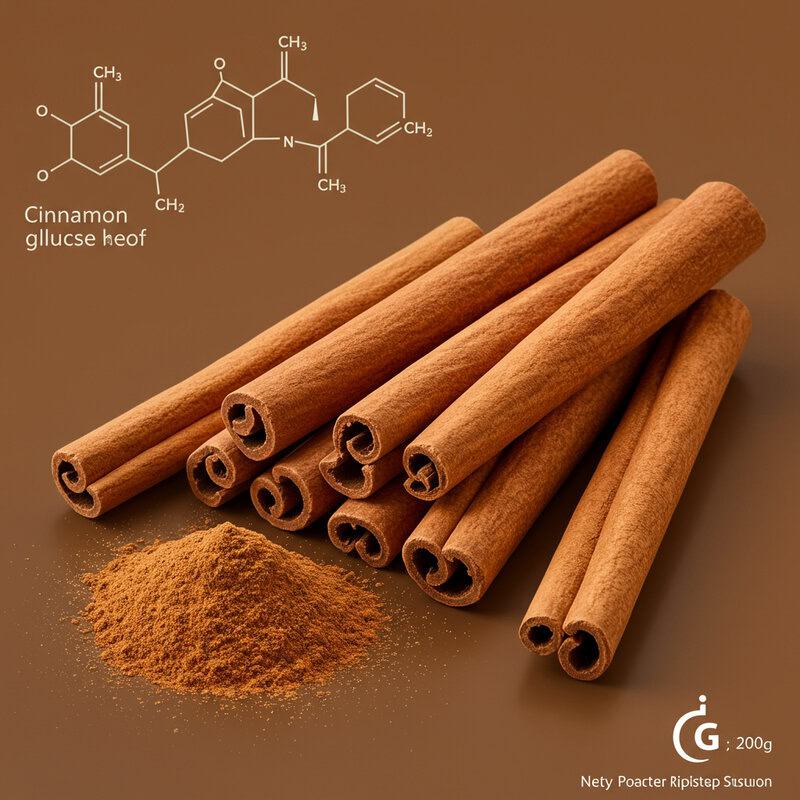
Cinnamon is a popular spice that has been shown to help lower blood sugar by enhancing insulin sensitivity. Research suggests that compounds in cinnamon, such as cinnamaldehyde, can mimic the effects of insulin and facilitate glucose uptake by cells. According to a review published in the journal Annals of Family Medicine, regular consumption of cinnamon can lead to modest but significant reductions in fasting blood glucose levels. Compared to other spices like turmeric or ginger, cinnamon appears to be particularly effective in its ability to influence insulin action.
For practical use, cinnamon can easily be incorporated into the diet. Sprinkle ground cinnamon over oatmeal, yogurt, or fruit, or stir it into coffee and teas for a flavor boost and potential metabolic benefits. It can also be added to savory dishes such as stews and curries. However, it is important to choose Ceylon cinnamon (“true” cinnamon) over Cassia cinnamon, as the latter contains higher levels of coumarin, which may be harmful in large amounts. Generally, 1-2 teaspoons per day is considered safe for most adults. Always consult with a healthcare provider before making significant dietary changes, especially if taking medication.
2. Apple Cider Vinegar
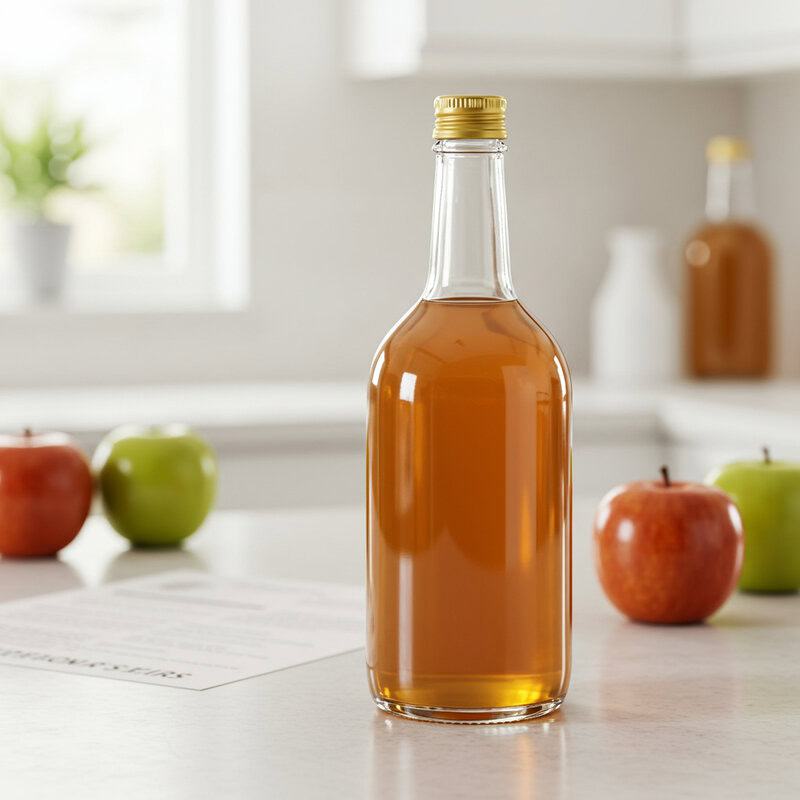
Apple cider vinegar (ACV) has gained recognition for its ability to help lower blood sugar levels, primarily due to its acetic acid content. Acetic acid slows the rate at which food leaves the stomach and inhibits the breakdown of starches, resulting in a slower release of glucose into the bloodstream. Studies, such as those published in the Journal of Diabetes Research, indicate that ACV can significantly improve insulin sensitivity after meals, particularly in people with insulin resistance.
When compared to other vinegars like wine vinegar, ACV contains similar levels of acetic acid, but its additional bioactive compounds may offer extra benefits. Both types can modestly impact blood sugar, but ACV is often preferred for its milder flavor and potential probiotic content. For safe consumption, dilute 1-2 tablespoons of ACV in a large glass of water and drink before or during meals. Undiluted vinegar can erode tooth enamel and irritate the throat, so always avoid consuming it straight. Individuals taking medications, especially for diabetes or heart conditions, should consult a healthcare provider beforehand due to possible interactions. For more information, visit Healthline’s guide on ACV and diabetes.
3. Leafy Greens
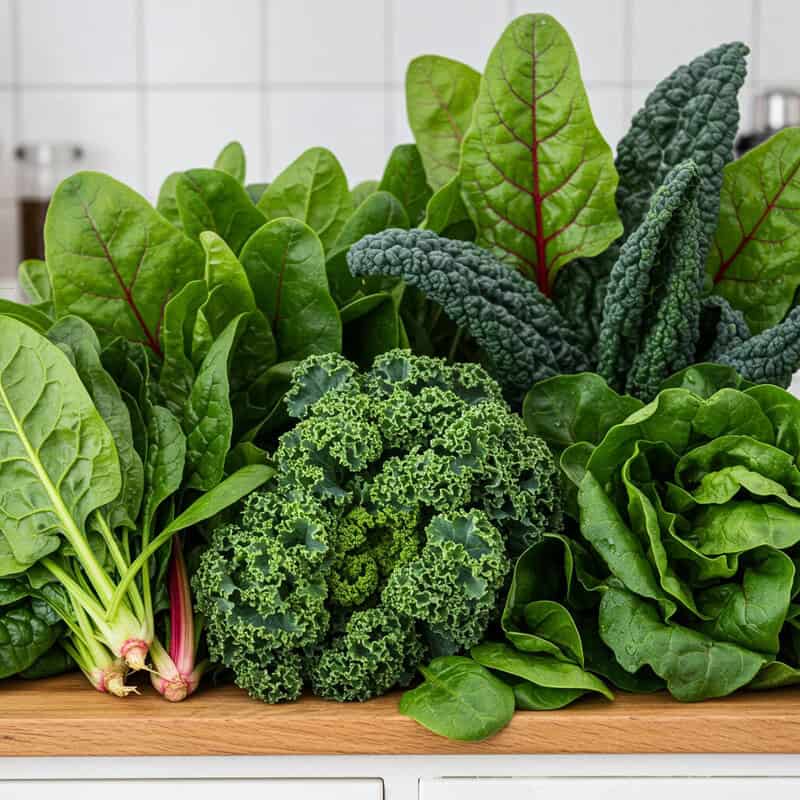
Leafy greens such as spinach, kale, and Swiss chard are nutrient-dense foods that play a significant role in blood sugar regulation. They are rich in fiber, which slows the absorption of glucose into the bloodstream, helping to prevent blood sugar spikes. Additionally, leafy greens contain antioxidants like lutein, zeaxanthin, and vitamin C, which reduce inflammation and oxidative stress that can worsen insulin resistance. According to a study in the British Medical Journal, increased consumption of green leafy vegetables is associated with a reduced risk of type 2 diabetes.
Compared to starchy vegetables such as potatoes and corn, leafy greens have far fewer carbohydrates and a lower glycemic index. This makes them an ideal choice for those managing blood sugar, as they provide essential nutrients without causing significant increases in glucose levels. Incorporating leafy greens into meals is easy and versatile. Add raw spinach or arugula to salads, blend kale or collard greens into smoothies, sauté Swiss chard with garlic for a quick side dish, or use leafy greens as a base for grain bowls. Their mild flavors and varied textures make them suitable for many cuisines and eating preferences.
4. Chia Seeds
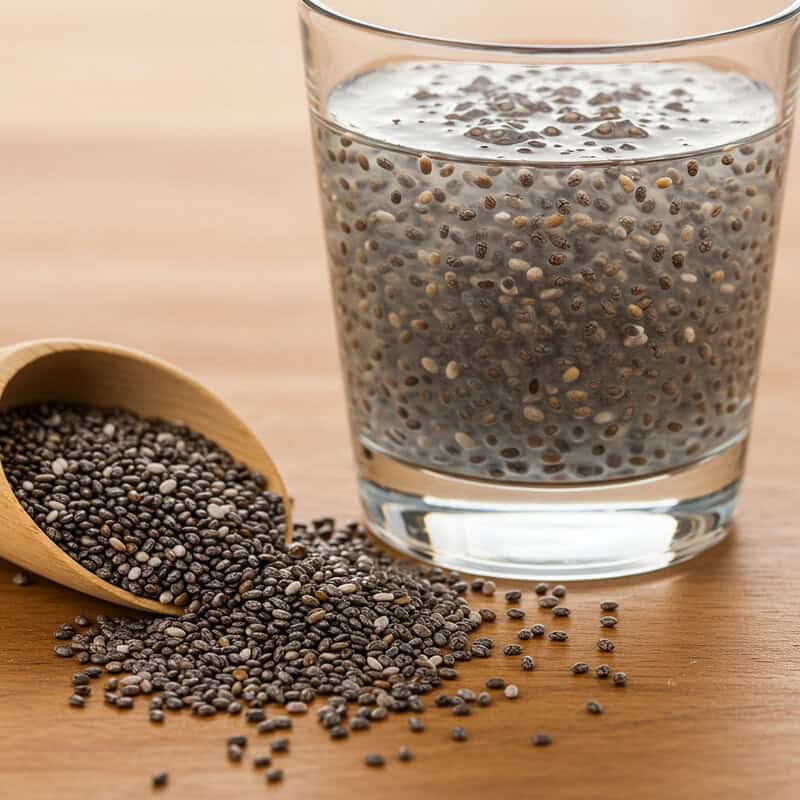
Chia seeds are a powerful source of soluble fiber, which plays a pivotal role in moderating blood sugar levels. When consumed, chia seeds absorb liquid and form a gel-like consistency in the digestive tract, which helps slow the absorption of carbohydrates and the subsequent release of glucose into the bloodstream. This effect can significantly minimize post-meal blood sugar spikes. Research published in the European Journal of Clinical Nutrition demonstrates that chia seed supplementation can lead to improved glycemic control, making them a valuable addition for those managing diabetes or prediabetes.
When compared to flaxseed, another popular superfood, chia seeds offer similar benefits in terms of fiber content but are slightly higher in soluble fiber, which may have a more pronounced effect on stabilizing blood sugar. Chia seeds also provide a complete plant-based protein and healthy omega-3 fatty acids. Incorporating chia seeds into meals is simple and versatile: sprinkle them over oatmeal, yogurt, or salads, mix into smoothies, or create chia pudding by soaking them in milk or non-dairy alternatives. Their neutral taste and unique texture make chia seeds an easy, effective way to support healthy blood sugar levels daily.
5. Greek Yogurt

Greek yogurt is renowned for its high protein content and beneficial probiotics, both of which play crucial roles in managing blood sugar. Protein helps slow the absorption of carbohydrates, reducing post-meal glucose spikes and supporting satiety, which can help regulate overall calorie intake. Probiotics, which are live beneficial bacteria found in fermented foods like Greek yogurt, have been shown to enhance gut health and may improve insulin sensitivity. A study published in Nutrients highlights the positive effects of fermented dairy products on glycemic control and metabolic health.
When compared to standard yogurt, Greek yogurt contains about twice the protein and significantly less sugar, making it a superior choice for those aiming to stabilize blood sugar levels. Standard yogurts are often higher in lactose and may contain added sugars, both of which can contribute to glucose spikes. For best results, opt for plain, unsweetened Greek yogurt. It can be enjoyed on its own, topped with fresh berries and chia seeds, or used as a creamy base for smoothies, salad dressings, or dips. Avoid flavored varieties, which often contain hidden sugars that can undermine the blood sugar benefits of this nutritious food.
6. Eggs
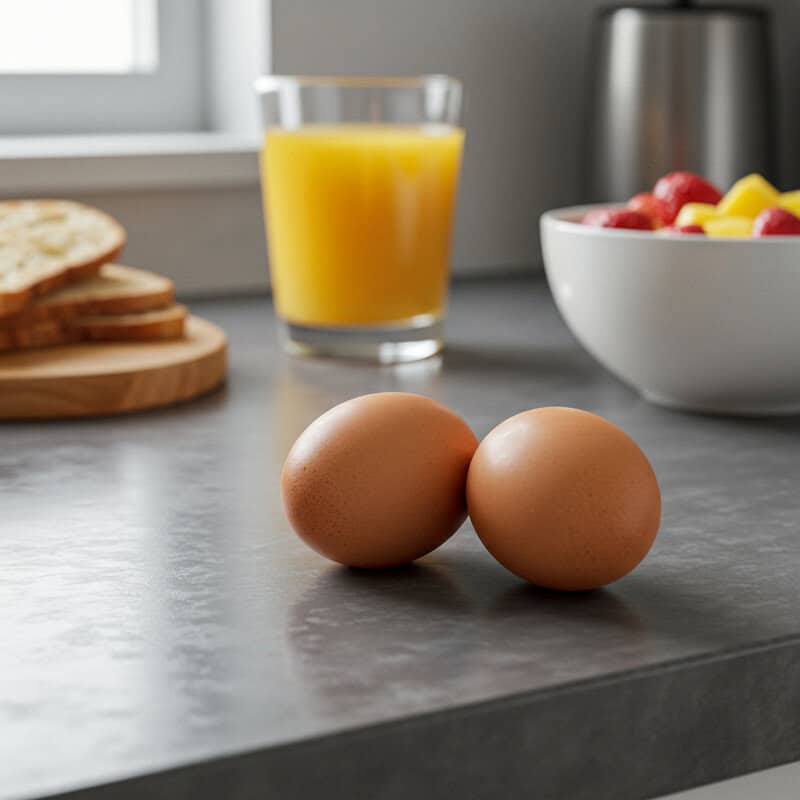
Eggs are an excellent source of high-quality, slow-digesting protein, making them a smart choice for blood sugar management. Unlike high-carbohydrate breakfast foods that can cause rapid spikes and crashes in blood glucose, eggs provide a sustained release of energy without significantly impacting blood sugar levels. Research published in the American Journal of Clinical Nutrition demonstrates that consuming eggs can improve satiety and support stable blood sugar profiles throughout the day.
Compared to foods like white bread, pastries, or sugary cereals, eggs are virtually free of carbohydrates and offer essential nutrients such as vitamin D, choline, and antioxidants like lutein. This makes eggs a superior breakfast option for those aiming to control glucose levels and avoid the energy crashes often associated with refined grains and sugars. For healthy preparation, consider boiling, poaching, or scrambling eggs with minimal added fat and salt. Pairing eggs with non-starchy vegetables or leafy greens can further enhance the meal’s nutritional value. Avoid frying eggs in large amounts of oil or butter, and steer clear of processed meats like bacon or sausage, which can contribute excess saturated fat and sodium to the meal.
7. Nuts
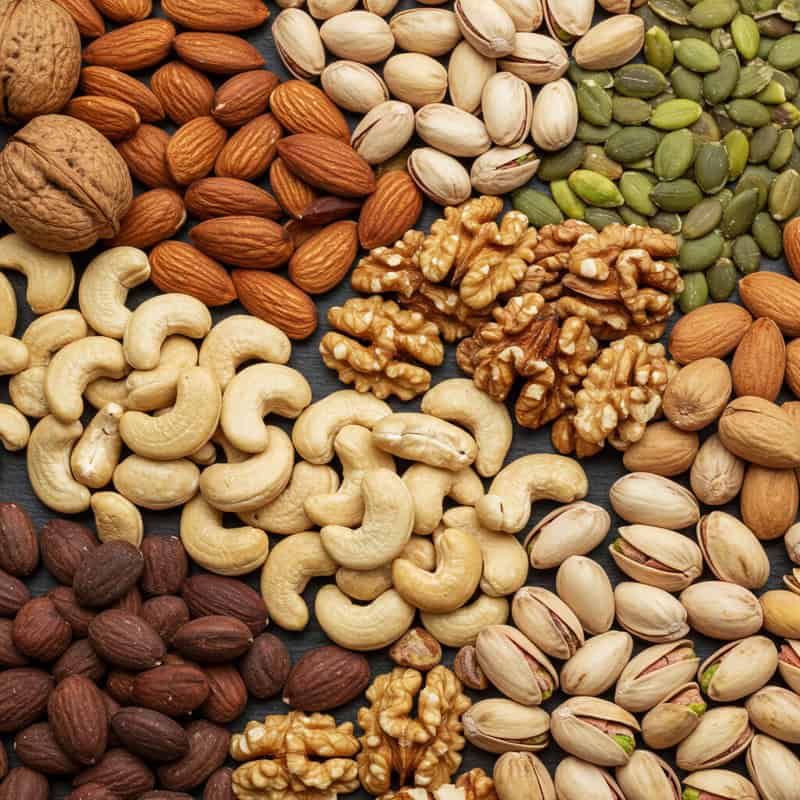
Nuts are a nutrient-rich food that offers a combination of healthy fats, fiber, and protein, all of which contribute to moderating the release of glucose into the bloodstream. The healthy monounsaturated and polyunsaturated fats found in nuts slow digestion and help prevent rapid increases in blood sugar after meals. In addition, the fiber content enhances satiety and further blunts glucose spikes. Clinical trials, such as one published in Diabetes Care, have shown that regular nut consumption can improve glycemic control and reduce the risk of type 2 diabetes.
Different types of nuts offer unique benefits. Almonds and walnuts are particularly high in beneficial fats and antioxidants, while pistachios provide more potassium and magnesium, both of which support metabolic health. Cashews are slightly higher in carbohydrates, while peanuts—technically legumes—are also a good source of protein. When selecting nuts, opt for raw or dry-roasted, unsalted varieties to avoid excess sodium and unhealthy additives. A recommended portion size is about a small handful, or roughly 1 ounce (28 grams), per day. Overconsumption can add unnecessary calories, so moderation is key. Nuts make an excellent snack or can be added to salads, oatmeal, or yogurt for sustained energy and blood sugar support.
8. Garlic

Garlic is celebrated not only for its flavor but also for its potential to improve blood sugar control. Its sulfur-containing compounds, particularly allicin, have been shown to enhance insulin sensitivity and support glucose metabolism. Research highlighted in the International Journal for Vitamin and Nutrition Research suggests that garlic supplementation can lower fasting blood sugar and may benefit people with type 2 diabetes. These effects are attributed to garlic’s ability to stimulate insulin secretion and reduce inflammatory markers associated with metabolic dysfunction.
The impact of garlic can vary depending on whether it is consumed raw or cooked. Raw garlic contains the highest concentration of active compounds, such as allicin, which is released when garlic is chopped or crushed. Cooking garlic can diminish some of these beneficial components, but it still retains many health-promoting properties. For maximum benefit, allow chopped or crushed garlic to rest for 5-10 minutes before heating, which helps preserve the active sulfur compounds. Add raw garlic to salad dressings, dips, or salsas, or incorporate lightly cooked garlic into stir-fries and roasted vegetables. Always start with small amounts to assess tolerance, as raw garlic can be quite pungent and may cause digestive discomfort in sensitive individuals.
9. Oats
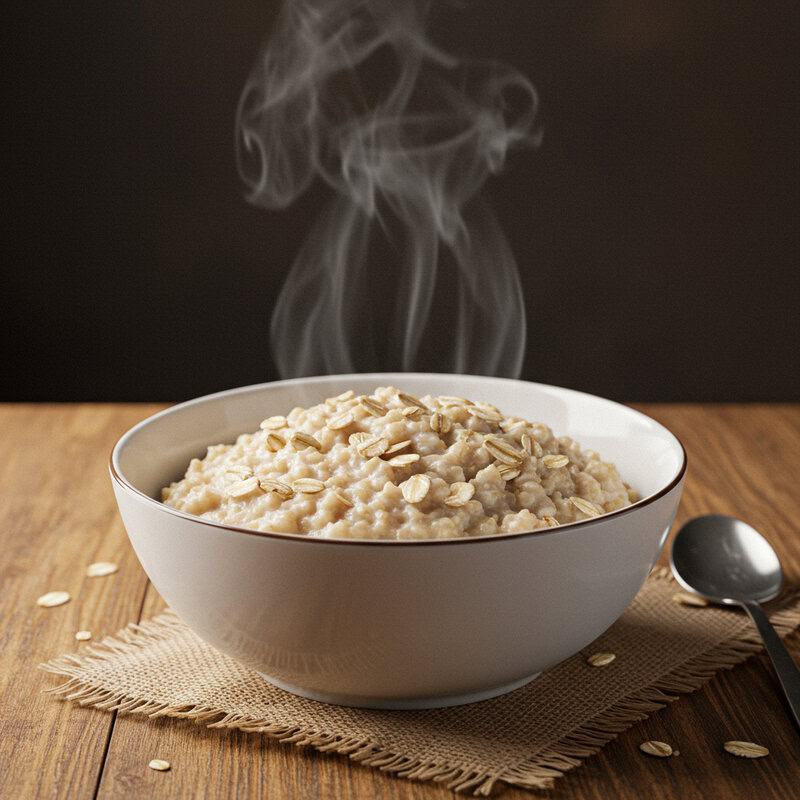
Oats are an excellent source of beta-glucan, a type of soluble fiber that plays a key role in slowing glucose absorption and stabilizing blood sugar levels. Beta-glucan forms a gel-like substance in the digestive tract, which delays gastric emptying and reduces the rate at which carbohydrates are broken down and absorbed. According to a study in the British Journal of Nutrition, regular consumption of oats can significantly lower postprandial (after-meal) blood glucose and improve insulin response in people with type 2 diabetes.
It’s important to distinguish between whole or steel-cut oats and instant oatmeal. Whole and steel-cut oats retain more fiber and nutrients, leading to a lower glycemic index and a gentler impact on blood sugar. In contrast, instant oatmeal is more processed, often contains added sugars, and is digested more quickly, which can cause rapid glucose spikes. For a healthy meal, prepare oats with water or low-fat milk and top with berries, nuts, or a sprinkle of cinnamon. Avoid pre-flavored packets that usually contain extra sugar. Oats can also be used in homemade granola, overnight oats, or as a base for savory dishes, offering a versatile way to support steady blood sugar control.
10. Berries
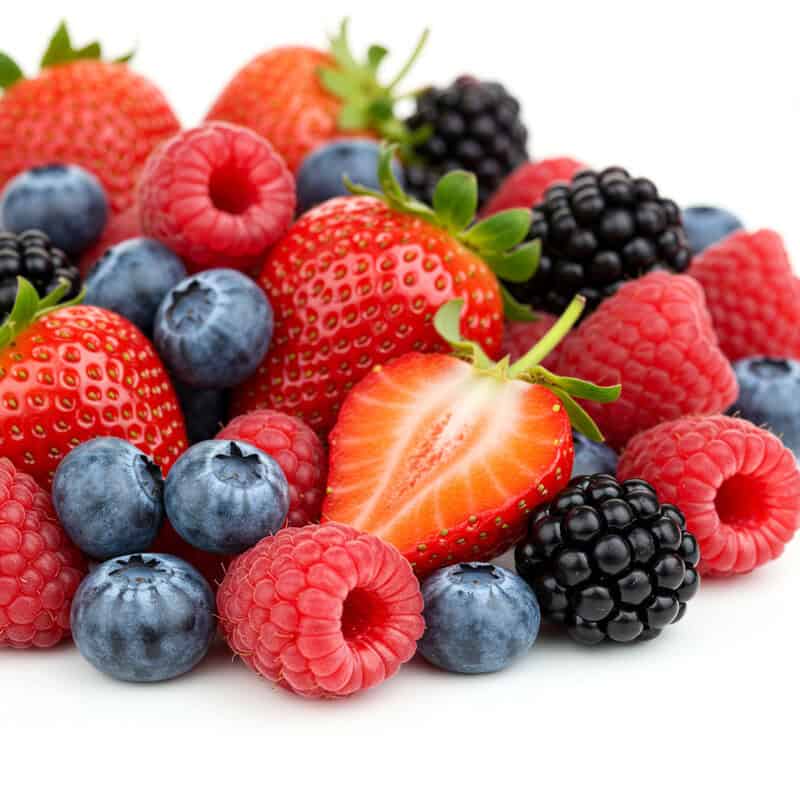
Berries, including strawberries, blueberries, raspberries, and blackberries, are nutritional powerhouses that support healthy blood sugar levels. They are rich in antioxidants such as anthocyanins, which have been shown to improve insulin sensitivity and reduce oxidative stress, both critical factors in blood sugar regulation. Their high fiber content slows the digestion and absorption of sugars, preventing rapid spikes in glucose after meals. According to a review published in the Journal of Nutritional Biochemistry, regular berry consumption is associated with improved glycemic control and a lower risk of developing type 2 diabetes.
Compared to higher sugar fruits like bananas, mangoes, or grapes, berries have a lower glycemic index and contain fewer total carbohydrates per serving. This makes them a smarter choice for those seeking to manage blood sugar. For convenient and healthy snacks, enjoy fresh berries on their own, mixed into Greek yogurt, or blended into smoothies. They can also be frozen and eaten as a refreshing treat or added to oatmeal and salads for natural sweetness and extra nutrients. Berries’ vibrant flavors and versatility ensure they fit easily into any meal plan focused on stable blood sugar.
11. Broccoli
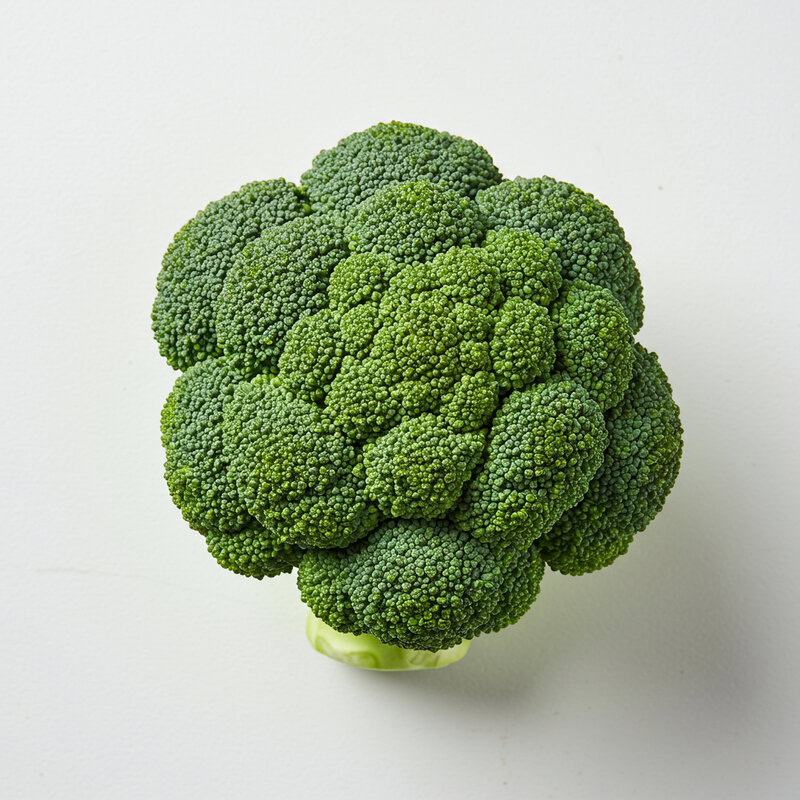
Broccoli is a standout cruciferous vegetable, largely because of its high concentration of sulforaphane, a powerful plant compound with significant benefits for blood sugar regulation. Sulforaphane has been shown to improve glucose metabolism by reducing oxidative stress and inflammation, as well as by stimulating enzymes that protect blood vessels from damage caused by high blood sugar. A study published in Science Translational Medicine found that sulforaphane-rich broccoli extract can lower fasting blood glucose and improve insulin sensitivity in people with type 2 diabetes.
Broccoli is comparable to other cruciferous vegetables like Brussels sprouts, kale, and cauliflower, all of which contain glucosinolates that are converted to bioactive compounds. However, broccoli tends to have higher levels of sulforaphane, making it particularly effective for supporting metabolic health. For optimal sulforaphane content, lightly steam or sauté broccoli rather than boiling, which can reduce nutrient levels. Add broccoli to stir-fries, salads, or omelets, or roast it with olive oil and garlic for a flavorful side dish. Chopping or crushing broccoli before cooking helps activate the enzymes needed to form sulforaphane, maximizing its health benefits and supporting healthy blood sugar levels.
12. Lentils
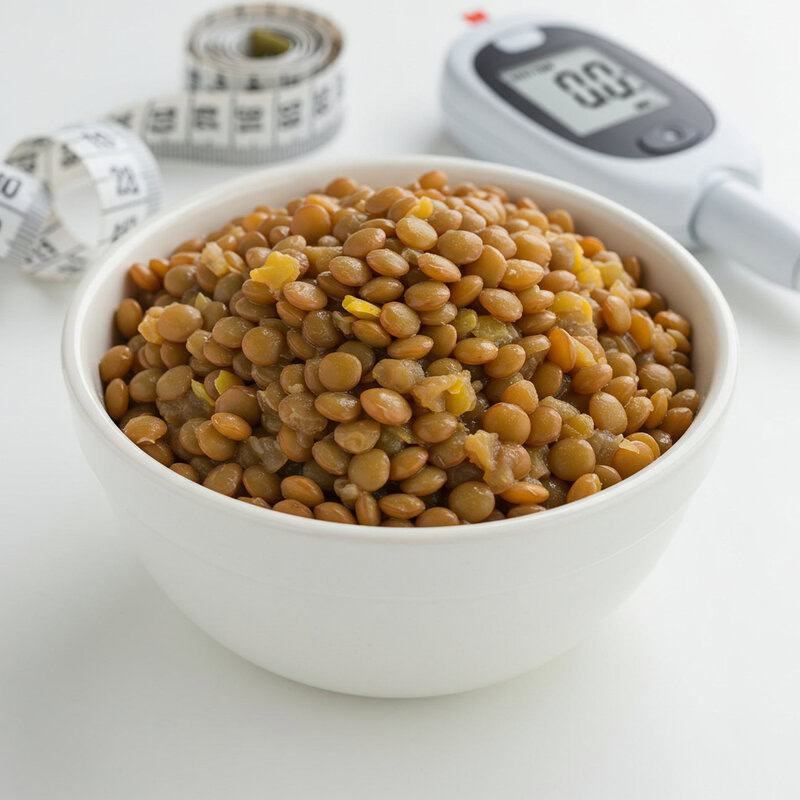
Lentils are a powerhouse of plant-based protein and dietary fiber, both of which are instrumental in stabilizing blood sugar levels. The protein content in lentils slows the digestion and absorption of carbohydrates, while the soluble fiber forms a gel-like substance in the gut that further delays glucose release into the bloodstream. Studies, such as one in the Journal of Nutrition, have demonstrated that meals containing lentils produce a lower blood sugar response compared to those with high-glycemic foods.
When compared to white rice, lentils have a much lower glycemic index and offer a greater array of nutrients, including iron, folate, and magnesium. White rice is quickly digested, often leading to rapid spikes in blood glucose, whereas lentils provide a slow, sustained energy release. To incorporate lentils into your diet, try adding them to soups, stews, and salads, or use them as a hearty base for vegetarian curries. Lentils also work well as a meat substitute in tacos, burgers, or shepherd’s pie. Their versatility and rich, earthy flavor make them an excellent choice for anyone aiming to manage or lower their blood sugar naturally.
13. Avocado
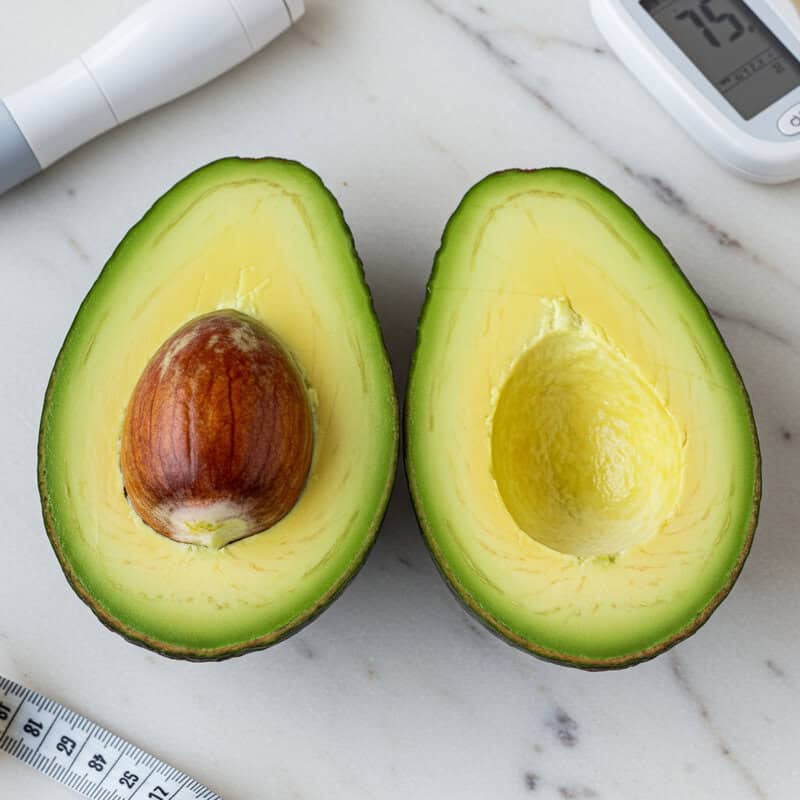
Avocado is celebrated for its abundance of monounsaturated fats, which play a key role in improving insulin sensitivity and supporting stable blood sugar levels. These healthy fats help slow the absorption of carbohydrates, reducing the risk of post-meal glucose spikes. Research in the Nutrition Journal shows that regular avocado consumption can support cardiovascular health and glycemic control, making it an excellent choice for people with or at risk for diabetes.
Compared to butter, which is high in saturated fat and can contribute to insulin resistance and increased cholesterol, avocado offers a heart-healthy alternative that can be easily substituted in many dishes. Avocado is naturally cholesterol-free and contains fiber, potassium, and antioxidants, giving it a nutritional edge over traditional spreads and toppings. To enjoy avocado healthfully, try spreading it on whole grain toast instead of butter, adding slices to salads, sandwiches, or wraps, or blending it into smoothies for a creamy texture. It can also be used to make guacamole or as a topping for tacos and grain bowls. Moderation is key, as avocado is calorie-dense, but its nutrient profile supports both blood sugar management and overall health.
14. Turmeric
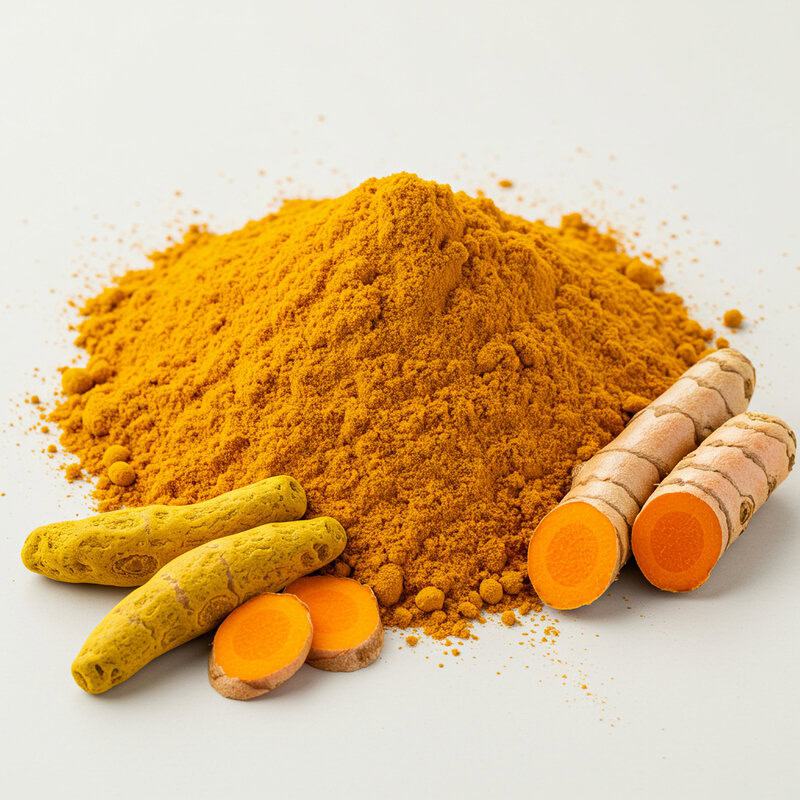
Turmeric, a golden-yellow spice widely used in South Asian cuisine, contains the active compound curcumin, which has demonstrated significant benefits for blood sugar regulation. Curcumin has been shown to enhance insulin sensitivity, improve glucose uptake by cells, and reduce inflammation—key factors in the management of diabetes and metabolic syndrome. A meta-analysis published in the Journal of Evidence-Based Complementary & Alternative Medicine found that curcumin supplementation led to notable reductions in fasting blood glucose and hemoglobin A1c levels.
When compared with ginger, another anti-inflammatory root, turmeric is particularly potent for its blood sugar-lowering effects. Ginger also offers glycemic benefits, but curcumin’s ability to modulate multiple metabolic pathways makes turmeric a superior choice for insulin sensitivity. To incorporate turmeric into meals, try adding it to curries, soups, or stews. It pairs well with black pepper, which enhances curcumin absorption. Turmeric can also be stirred into scrambled eggs, rice, or roasted vegetables, or blended into smoothies and teas for a warming, earthy flavor. For best results, use fresh turmeric root or high-quality ground turmeric, and include a fat source (like olive oil or coconut milk) to boost bioavailability.
15. Beans
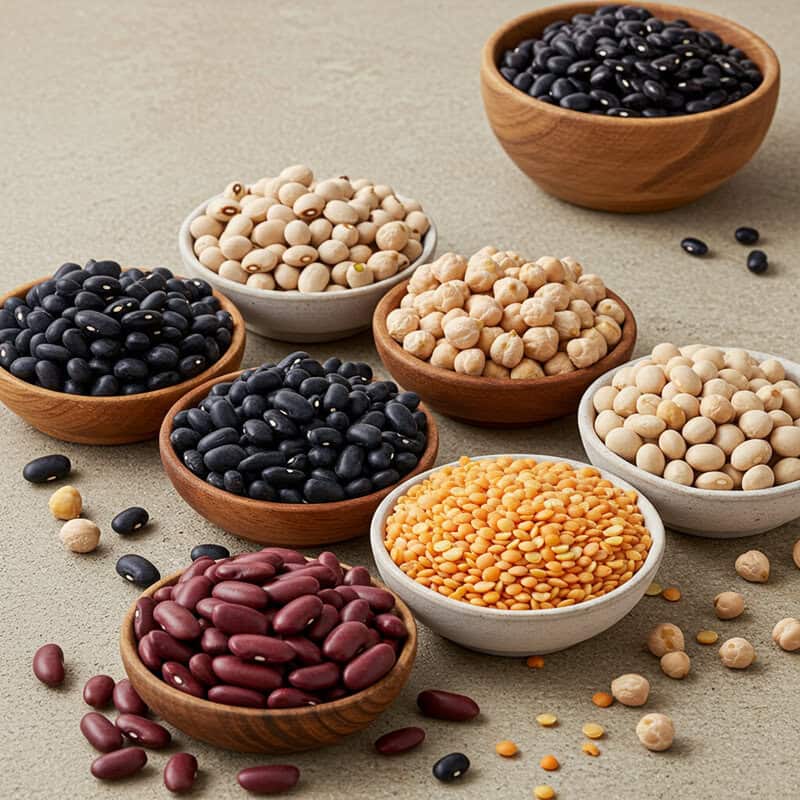
Beans, including black beans, kidney beans, chickpeas, and lentils, are highly valued for their low glycemic index and exceptional fiber content, both of which help regulate blood sugar levels. The combination of complex carbohydrates and soluble fiber in beans slows digestion and glucose absorption, leading to steadier blood sugar readings after meals. According to research published in the Archives of Internal Medicine, people who regularly consume beans experience improved glycemic control and reduced risk of type 2 diabetes.
In comparison to potatoes, beans offer a far lower glycemic index and a higher concentration of both protein and fiber. While potatoes, especially when mashed or fried, can rapidly elevate blood glucose, beans provide a slow, sustained release of energy. To incorporate beans into your diet, add them to salads, soups, and stews, or use them as a filling for burritos, tacos, or wraps. Beans blend well into veggie burgers, chili, or dips like hummus, making them a versatile, cost-effective, and nutritious staple. For convenience, canned beans can be rinsed and drained to reduce sodium content. Their adaptability and health benefits make beans a smart choice for blood sugar management.
16. Salmon

Salmon is an excellent source of omega-3 fatty acids, particularly EPA and DHA, which play a crucial role in reducing inflammation and improving glucose metabolism. Chronic inflammation is linked to insulin resistance and higher blood sugar levels, so consuming anti-inflammatory foods like salmon can support better glycemic control. Research published in the European Journal of Clinical Nutrition indicates that regular intake of fatty fish, such as salmon, is associated with lower levels of inflammation and improved insulin sensitivity in people with metabolic disorders.
Compared to fried fish, which is often breaded and cooked in unhealthy oils, baked or grilled salmon retains its beneficial fats and nutrients without added saturated fat or refined carbohydrates. Fried fish can contribute to higher blood sugar and cholesterol due to the preparation method. For healthy meal ideas, try baking salmon with herbs and lemon, grilling with a light marinade, or poaching in a flavorful broth. Salmon pairs well with leafy greens, roasted vegetables, or lentil salads for a balanced meal. Incorporating wild-caught salmon into your diet two to three times per week can help support heart health and blood sugar balance while offering a delicious, nutrient-rich protein source.
17. Sweet Potatoes
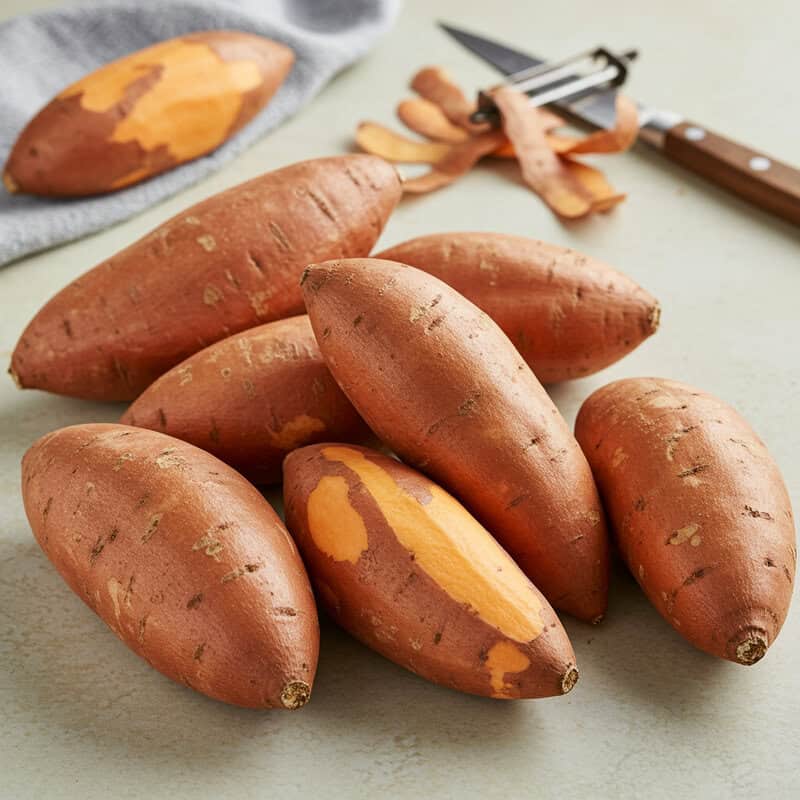
Sweet potatoes are a nutrient-dense, complex carbohydrate that can help regulate blood sugar thanks to their high fiber and lower glycemic index compared to many other starchy foods. The fiber in sweet potatoes, particularly when the skin is left on, slows digestion and the release of glucose into the bloodstream, resulting in fewer spikes and crashes in blood sugar. According to the Journal of Medicinal Food, sweet potatoes may improve insulin sensitivity and contribute to better long-term glycemic control.
When compared to white potatoes, sweet potatoes have a lower glycemic index and provide more fiber, vitamins A and C, and antioxidants such as beta-carotene. White potatoes, especially when baked or mashed, can cause a rapid increase in blood glucose, whereas sweet potatoes offer a slower, more gradual energy release. To enjoy sweet potatoes healthfully, try roasting them with olive oil and spices, baking whole and topping with Greek yogurt and chives, or slicing into wedges for oven-baked fries. Sweet potatoes also work well in soups, stews, or as a base for grain bowls. Their natural sweetness and versatility make them a delicious and blood sugar-friendly addition to many meals.
18. Quinoa
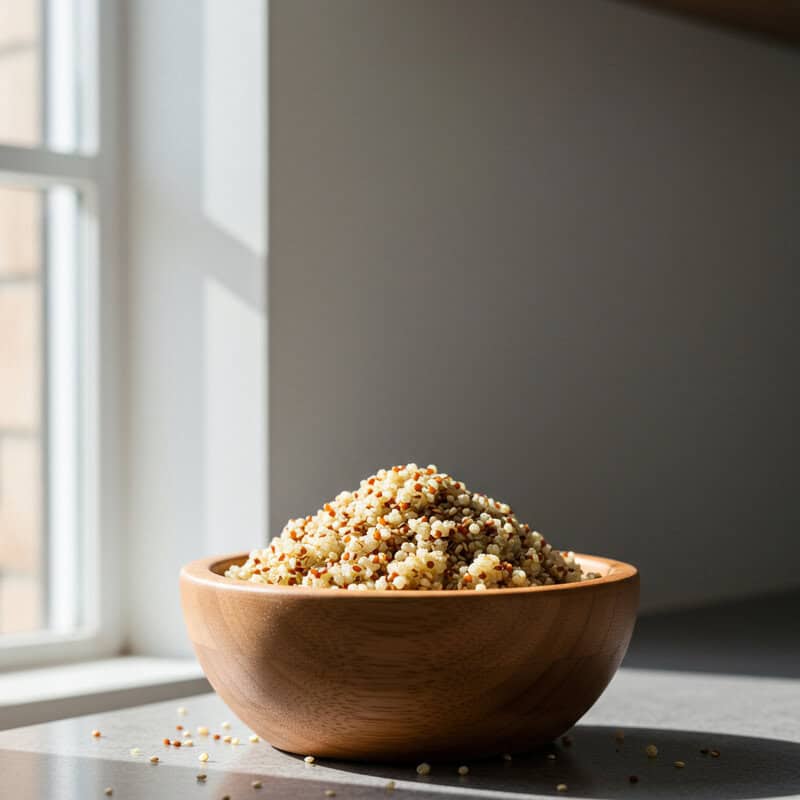
Quinoa is a highly nutritious, gluten-free whole grain that stands out for its impressive protein and fiber content. Each serving of quinoa provides all nine essential amino acids and contains more fiber than most other grains, which helps to slow the digestion and absorption of carbohydrates. This results in a gradual release of glucose into the bloodstream, supporting stable blood sugar levels. Research in the Journal of Nutritional Science notes that quinoa consumption can improve postprandial glycemic response and support metabolic health in individuals at risk for diabetes.
When compared to white rice, quinoa is superior in both protein and fiber, offering a lower glycemic index and greater satiety. White rice is quickly broken down into glucose, often leading to blood sugar spikes, while quinoa’s nutrient profile promotes steadier energy. Quinoa is extremely versatile: use it as a base for salads, grain bowls, or stir-fries; serve alongside grilled vegetables, fish, or lean meats; or mix with beans and spices for a hearty vegetarian main dish. Quinoa can also be enjoyed as a hot breakfast cereal with fruit and nuts. Its mild, nutty flavor and fluffy texture make it an appealing, blood sugar-friendly alternative to refined grains.
19. Carrots
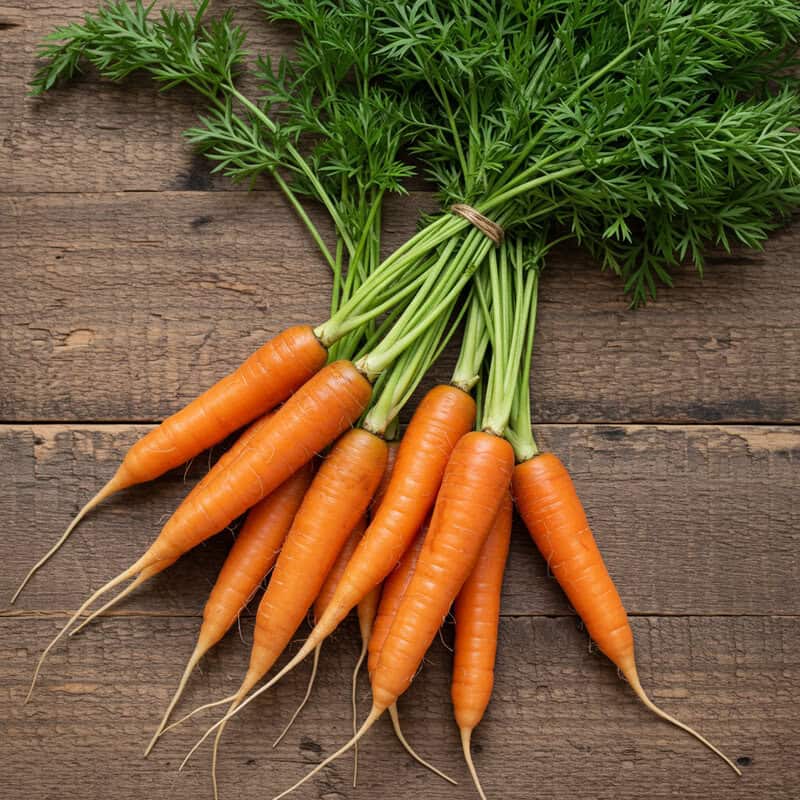
Carrots are a vibrant root vegetable that support blood sugar control through their fiber content and abundance of antioxidants, particularly beta-carotene. The fiber in carrots slows the absorption of sugars during digestion, helping to prevent rapid increases in blood glucose. Additionally, antioxidants in carrots reduce oxidative stress and inflammation, both of which are linked to insulin resistance and metabolic dysfunction. Research reviewed in the Journal of Functional Foods suggests that regular consumption of antioxidant-rich vegetables like carrots may contribute to improved glycemic control.
Compared to corn, carrots have a lower glycemic index and fewer total carbohydrates per serving, making them a more favorable choice for blood sugar management. Corn, while nutritious, is higher in starchy carbohydrates that can cause larger glucose fluctuations when eaten in excess. Carrots can be enjoyed in a variety of ways: snack on raw carrot sticks with hummus, slice them into salads, roast with olive oil and herbs for a sweet-savory side, or blend into smoothies for natural sweetness. Their portability and crunch also make carrots an easy, healthy alternative to processed snack foods for anyone looking to stabilize their blood sugar throughout the day.
20. Tomatoes

Tomatoes are a rich source of lycopene, a powerful antioxidant known to reduce inflammation and support healthy blood sugar management. Lycopene helps protect cells from oxidative damage, which is linked to insulin resistance and metabolic complications associated with elevated glucose levels. Research published in the International Journal of Food Sciences and Nutrition has shown that regular tomato consumption can lower markers of inflammation and may help improve glycemic control in people with type 2 diabetes.
When compared to processed tomato products, such as ketchup or canned tomato sauces, fresh tomatoes are lower in added sugars and sodium, making them a healthier choice for blood sugar regulation. Many processed tomato products contain significant amounts of sugar and salt, which can undermine their beneficial effects. To incorporate fresh tomatoes into your diet, add sliced tomatoes to salads, layer them on whole grain sandwiches, or use cherry tomatoes as a snack. Fresh tomatoes can also be chopped into salsas, blended into gazpacho, or roasted for a rich, savory addition to grain bowls and pasta dishes. Their natural sweetness and versatility make tomatoes a flavorful, nutritious option for supporting stable blood sugar levels.
21. Pumpkin Seeds

Pumpkin seeds, also known as pepitas, are a potent source of magnesium, a mineral essential for optimal insulin function and blood sugar control. Magnesium plays a critical role in glucose metabolism by supporting insulin secretion and enhancing the body’s ability to utilize glucose effectively. Studies, such as those reported in the World Journal of Diabetes, have found that higher magnesium intake is associated with a reduced risk of type 2 diabetes and improved insulin sensitivity.
Compared to sunflower seeds, pumpkin seeds generally provide more magnesium per serving, though both are rich in healthy fats, protein, and fiber that contribute to satiety and steady glucose release. Sunflower seeds are also nutritious but may contain more sodium if salted. For a healthy snack, choose raw or dry-roasted, unsalted pumpkin seeds. Enjoy them on their own, mix into trail mix with nuts and dried berries, or sprinkle over salads, yogurt, or oatmeal for added crunch and nutrients. Pumpkin seeds can also be blended into smoothies or used as a topping for roasted vegetables. Their versatility and nutritional value make them an easy, satisfying addition to a blood sugar-friendly diet.
22. Pears
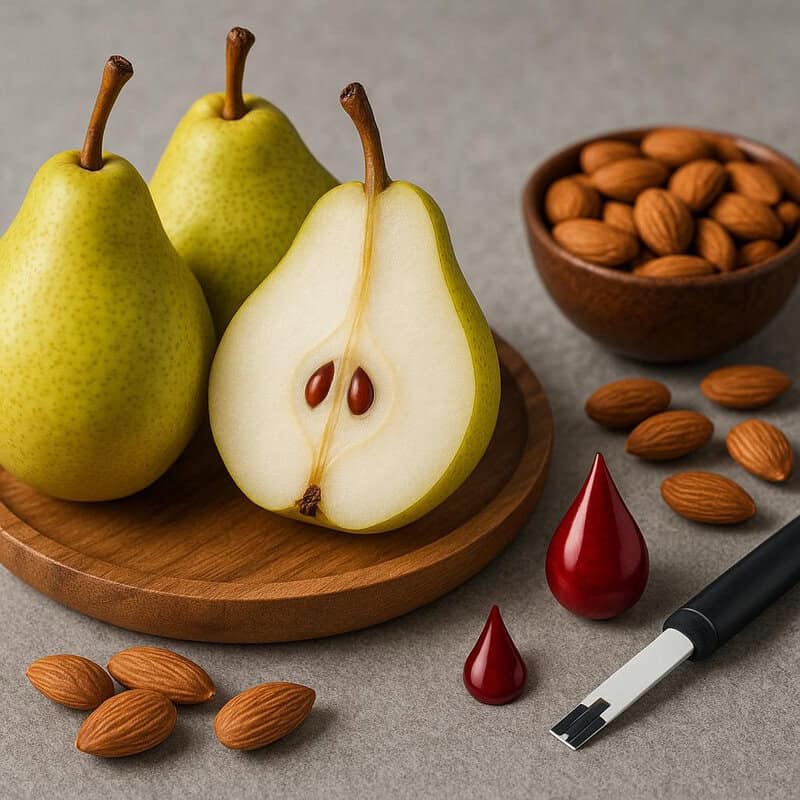
Pears are an excellent fruit choice for blood sugar management, largely due to their high soluble fiber content. Soluble fiber forms a gel-like substance in the digestive tract, which slows the absorption of glucose and helps prevent rapid spikes in blood sugar after eating. According to research published in the Journal of Food Science, regularly consuming pears is associated with improved glycemic control and a reduced risk of developing type 2 diabetes.
When compared to apples, pears offer a similar amount of fiber and a comparable glycemic index, making both fruits favorable for maintaining steady blood sugar levels. However, pears tend to have slightly more soluble fiber, especially in their skins, which gives them a subtle advantage in supporting glucose regulation. For healthy snacking, enjoy fresh pears sliced on their own, paired with a handful of nuts for added protein and healthy fat, or chopped into salads for natural sweetness and crunch. Pears also work well baked with cinnamon for a warming dessert or blended into smoothies. Always eat pears with the skin on to maximize fiber intake and enjoy the full blood sugar benefits this delicious fruit can offer.
23. Barley
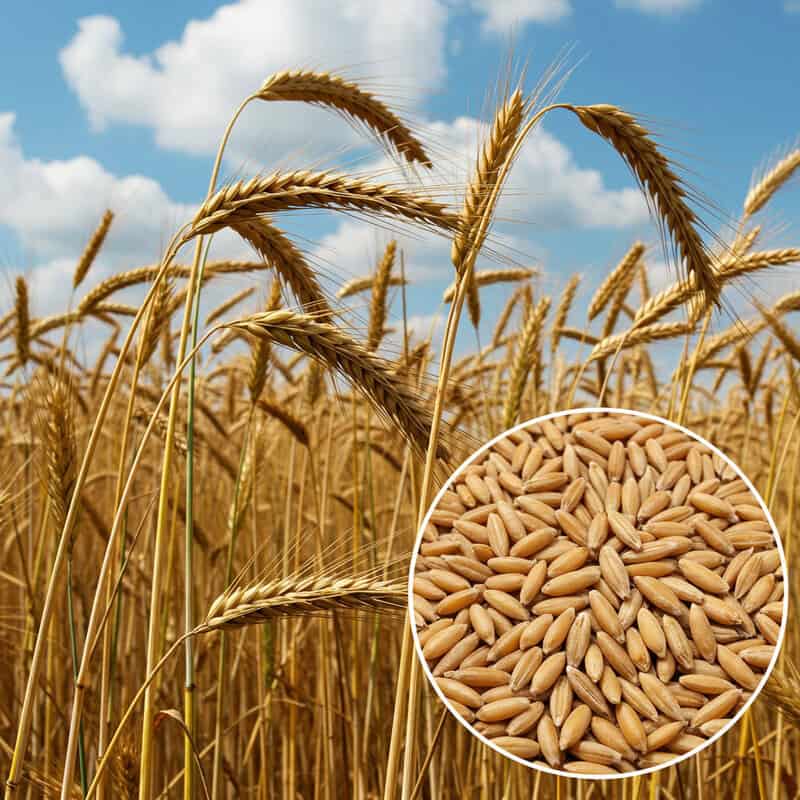
Barley is a whole grain celebrated for its high content of beta-glucans, a type of soluble fiber that plays a powerful role in reducing blood sugar spikes after meals. Beta-glucans form a viscous gel in the digestive tract, which slows gastric emptying and the absorption of glucose, resulting in a more gradual increase in blood sugar. Research published in the European Journal of Nutrition demonstrates that barley consumption significantly improves postprandial blood glucose and insulin response compared to refined grains.
When compared to white bread, barley has a much lower glycemic index and offers far more fiber, making it a superior option for stable blood sugar control. White bread, made from refined flour, is digested quickly and can cause rapid increases in glucose levels. Barley, on the other hand, provides not only beta-glucans but also important vitamins and minerals. To enjoy barley, try adding cooked pearled barley to soups, stews, or salads for a chewy, nutty texture. It can also serve as a hearty base for grain bowls or be mixed with vegetables and herbs for a simple side dish. Barley flakes make a wholesome, fiber-rich alternative to traditional hot cereals.
24. Brussels Sprouts

Brussels sprouts are a fiber-rich cruciferous vegetable, loaded with antioxidants and micronutrients that support healthy blood sugar levels. The fiber in Brussels sprouts helps slow the absorption of carbohydrates, reducing post-meal glucose spikes and supporting longer-lasting satiety. Additionally, they contain antioxidants such as vitamin C, kaempferol, and glucosinolates, which combat oxidative stress and inflammation—two factors linked to insulin resistance. According to research in the International Journal of Molecular Sciences, regular consumption of cruciferous vegetables like Brussels sprouts may lower the risk of type 2 diabetes and improve metabolic health.
Compared to cabbage, Brussels sprouts offer a similar antioxidant profile but have a slightly higher fiber content and denser texture, making them more filling. Both vegetables are excellent choices for blood sugar regulation, but Brussels sprouts’ unique combination of fiber and bioactive compounds can offer added benefits. For delicious preparation, try roasting Brussels sprouts with olive oil and garlic until caramelized, shredding them into salads, or sautéing with balsamic vinegar for a savory side dish. They also pair well with nuts and seeds for extra crunch and nutrition. Their versatility and nutritional value make Brussels sprouts a flavorful addition to a blood sugar-friendly diet.
25. Oranges

Oranges are a citrus fruit packed with vitamin C and dietary fiber, both of which play important roles in blood sugar regulation. Vitamin C functions as a potent antioxidant, helping to reduce inflammation and oxidative stress that can contribute to insulin resistance. The fiber in oranges, particularly when the fruit is eaten whole, slows the absorption of sugars and promotes more stable blood glucose levels. According to research published in the Journal of Nutritional Biochemistry, higher intakes of vitamin C and fiber-rich fruits are associated with improved glycemic control and lower risk of type 2 diabetes.
It’s important to differentiate between whole oranges and orange juice. While whole oranges provide fiber and a modest glycemic impact, orange juice lacks fiber and delivers concentrated sugars, which can cause rapid spikes in blood glucose. For best results, enjoy oranges as a snack, add segments to green salads, or mix chopped oranges into yogurt or cottage cheese. Pairing oranges with a protein or healthy fat—such as a handful of nuts—can further moderate their effect on blood sugar. Always choose whole fruit over juice to maximize antioxidants, fiber, and the blood sugar benefits that oranges naturally provide.
26. Edamame

Edamame, or young green soybeans, are a powerhouse of plant-based protein and dietary fiber, both of which help stabilize blood sugar levels by slowing digestion and the absorption of glucose. The protein in edamame promotes satiety and helps prevent sudden spikes in blood sugar after meals, while the fiber content supports digestive health and glucose regulation. Research in the Journal of Medicinal Food highlights that regular soybean consumption, including edamame, can improve glycemic control and support healthy cholesterol levels.
Compared to mature, regular soybeans, edamame is typically lower in calories and fat but still provides a substantial amount of protein and fiber. Its milder flavor and tender texture make it more appealing as a snack or salad ingredient. Edamame can be enjoyed steamed or boiled in the pod, sprinkled lightly with sea salt, or shelled and added to salads, grain bowls, or stir-fries. You can also blend edamame into hummus or dips for a protein-rich spread. Edamame’s versatility and nutrient density make it an excellent, convenient choice for anyone looking to maintain stable blood sugar levels while enjoying a satisfying and wholesome snack.
27. Flaxseed

Flaxseed is a nutritional powerhouse loaded with lignans and soluble fiber, both of which contribute to improved blood sugar regulation. Lignans are plant compounds with antioxidant properties that may enhance insulin sensitivity, while the soluble fiber in flaxseed forms a gel in the digestive tract that slows carbohydrate absorption and helps prevent spikes in blood glucose. According to research published in the Journal of Food Science and Technology, regular flaxseed consumption is linked to better glycemic control and reduced risk of type 2 diabetes.
Compared to chia seeds, flaxseed offers similar benefits in blood sugar management. While both seeds are rich in omega-3 fatty acids and fiber, flaxseed is particularly high in lignans, which provide additional antioxidant effects. For maximum nutritional benefits, use ground flaxseed rather than whole, as it is easier to digest and absorb. Sprinkle ground flaxseed over oatmeal, yogurt, or salads, blend into smoothies, or mix into baked goods like muffins and breads. Flaxseed can also be used as a vegan egg substitute by combining one tablespoon of ground flaxseed with three tablespoons of water. Its mild, nutty flavor makes flaxseed an easy addition to a variety of meals and snacks.
28. Cauliflower
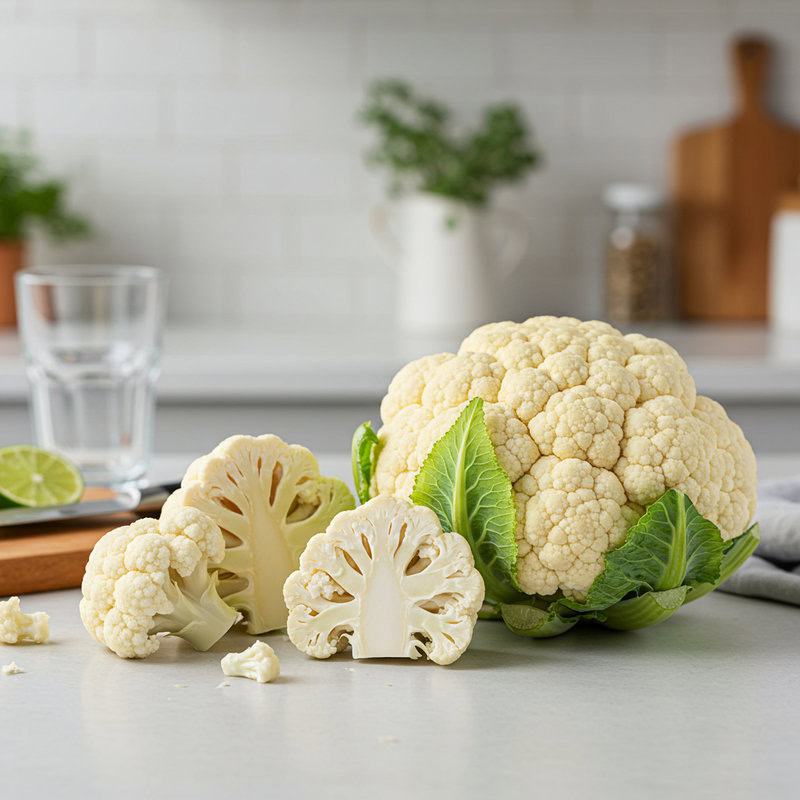
Cauliflower is a versatile vegetable renowned for its low carbohydrate content and high fiber, making it an excellent choice for managing blood sugar levels. Its fiber content slows the absorption of glucose, resulting in a gentler impact on blood sugar after eating. Cauliflower is also rich in vitamins, minerals, and antioxidants, which help combat inflammation and support metabolic health. Research in the Journal of Evidence-Based Complementary & Alternative Medicine discusses the benefits of cruciferous vegetables like cauliflower for improving insulin sensitivity and reducing diabetes risk.
When compared to potatoes, cauliflower contains significantly fewer carbohydrates and calories, and does not cause the same rapid rise in blood glucose. Potatoes, especially when mashed or fried, are quickly digested and often lead to glucose spikes, while cauliflower offers a more gradual, steady energy release. Cauliflower’s mild flavor and texture make it an ideal substitute for higher-carb foods: mash cooked cauliflower as a stand-in for mashed potatoes, use riced cauliflower in place of white rice, or create pizza crusts and flatbreads with blended cauliflower. Roasted or steamed, cauliflower can also be tossed into salads, soups, or stir-fries, providing a nutrient-dense, blood sugar-friendly addition to any meal.
29. Grapefruit

Grapefruit is a refreshing citrus fruit notable for its content of naringenin, a bioactive flavonoid that plays a beneficial role in glucose metabolism. Naringenin has been shown to improve insulin sensitivity, reduce inflammation, and support the regulation of blood sugar levels by influencing key pathways involved in glucose uptake and breakdown. Research published in the Journal of Nutritional Biochemistry highlights naringenin’s ability to help prevent spikes in blood sugar and enhance overall metabolic health.
When compared to sweeter citrus fruits like oranges or tangerines, grapefruit generally has a lower glycemic index and fewer sugars per serving, making it a preferable choice for those managing blood sugar. Its slightly bitter, tangy flavor also means that people are less likely to overconsume it, which can be helpful for portion control. For healthy serving ideas, enjoy grapefruit halves sprinkled with cinnamon, add segments to green salads for a burst of flavor, or blend into smoothies with spinach and berries. Grapefruit pairs well with avocado, seafood, and leafy greens. Note that grapefruit can interact with certain medications, so consult your healthcare provider if you are taking prescription drugs.
30. Green Tea

Green tea is celebrated for its rich content of catechins, a group of powerful antioxidants that have been shown to support blood sugar regulation. The most studied catechin, epigallocatechin gallate (EGCG), may improve insulin sensitivity and assist in lowering blood glucose by reducing inflammation and oxidative stress in the body. According to a review in the Journal of Nutrition, daily green tea consumption is associated with improved glycemic control and a reduced risk of developing type 2 diabetes.
When compared to black tea, green tea contains higher levels of catechins because it is less oxidized during processing. While black tea also offers health benefits, its theaflavins and thearubigins are different types of polyphenols that may not exert the same direct effect on blood sugar. For ideal consumption, brew green tea with hot (but not boiling) water to maximize catechin availability. Aim for two to four cups per day, unsweetened, to avoid added sugars. Green tea can be enjoyed hot or cold, and pairs well with lemon or mint. Its gentle caffeine content also makes it a suitable alternative to sugary beverages for those focusing on stable blood sugar levels.
31. Peanuts
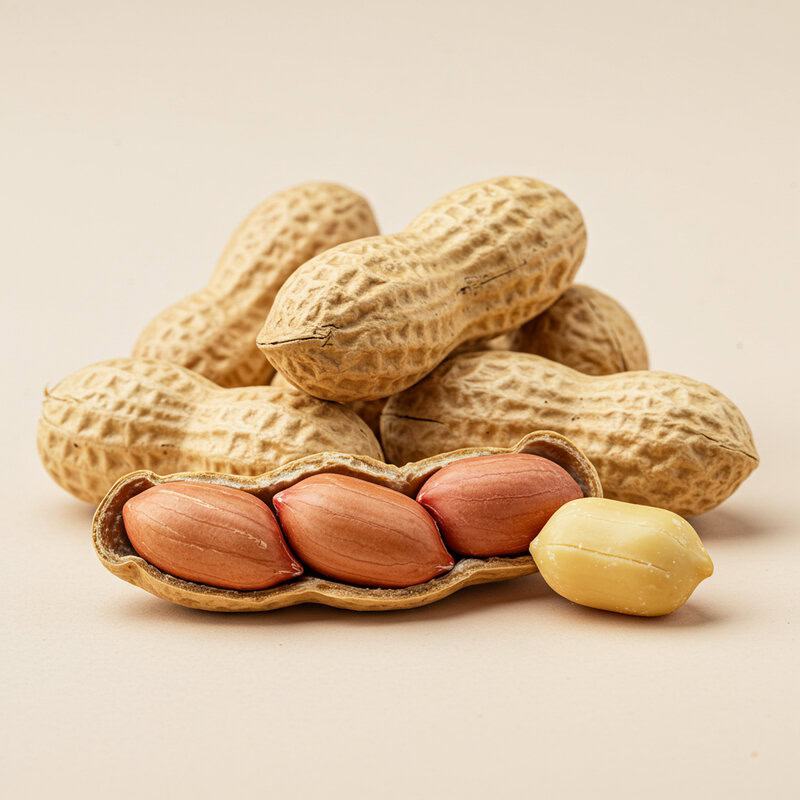
Peanuts, although technically legumes, are well-known for their low glycemic index and high content of healthy monounsaturated and polyunsaturated fats. These properties help slow digestion and the absorption of carbohydrates, resulting in a gradual rise in blood sugar rather than a rapid spike. Studies such as those published in the European Journal of Clinical Nutrition highlight that regular peanut consumption can improve glycemic control and support heart health in individuals with diabetes or metabolic syndrome.
When compared to peanut butter, whole peanuts generally contain fewer additives and no added sugars or hydrogenated oils, making them a healthier choice for blood sugar management. Many commercial peanut butters contain added sweeteners, salt, or unhealthy fats, which can undermine their nutritional value. For healthy snacking, opt for unsalted, dry-roasted peanuts or natural peanut butter made with just peanuts and perhaps a pinch of salt. Peanuts make a convenient on-the-go snack, can be tossed into salads for extra crunch, or paired with apple slices for a balanced treat. Moderation is important, as peanuts are calorie-dense, so stick to a small handful or two tablespoons of peanut butter per serving to maintain portion control.
32. Zucchini
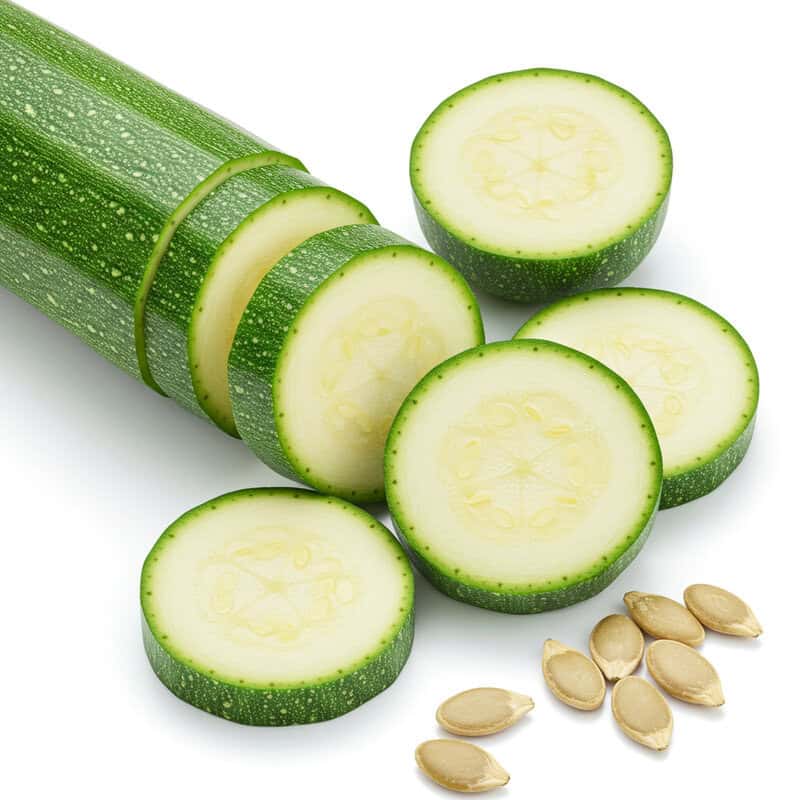
Zucchini is a low-carbohydrate, high-water-content vegetable that supports blood sugar management by providing fiber, vitamins, and minerals without contributing to glucose spikes. Its minimal carbohydrate load makes it especially suitable for individuals who need to control their post-meal blood sugar. According to the U.S. Department of Agriculture FoodData Central, one cup of sliced zucchini contains fewer than 4 grams of carbohydrates, making it an excellent alternative to higher-carb foods.
When compared to traditional pasta, zucchini is dramatically lower in carbohydrates and calories. Pasta, especially refined varieties, is quickly digested and can cause rapid increases in blood glucose. Zucchini noodles, or “zoodles,” offer a satisfying texture and can be used as a direct substitute in many pasta dishes, helping reduce the glycemic impact of meals. To prepare, simply spiralize or thinly slice zucchini and sauté briefly in olive oil, or serve raw as a crisp base for sauces. Zucchini can also be grilled, roasted, or stuffed with lean proteins and vegetables. Its mild flavor and versatility make zucchini a valuable addition to a blood sugar-friendly diet that doesn’t sacrifice taste or variety.
33. Asparagus

Asparagus is a nutrient-dense vegetable, notable for its high fiber content and valuable micronutrient chromium. Chromium plays an essential role in enhancing insulin’s effectiveness, aiding in the maintenance of stable blood sugar levels. The fiber in asparagus further supports glucose control by slowing the absorption of sugars during digestion, resulting in more gradual increases in blood glucose after meals. According to findings in the British Journal of Nutrition, regular consumption of asparagus may improve insulin secretion and sensitivity, benefiting people at risk for or managing diabetes.
Compared to green beans, asparagus offers a slightly higher chromium content and similar levels of dietary fiber, making both vegetables excellent choices for blood sugar regulation. However, asparagus is also rich in antioxidants such as glutathione and vitamin E, which help reduce inflammation and oxidative stress linked to metabolic disorders. For serving ideas, asparagus can be steamed, roasted, or grilled with a drizzle of olive oil and a squeeze of lemon. It pairs well with eggs, fish, or lean meats, and can be added to salads, pastas, or grain bowls. Its unique flavor and nutritional benefits make asparagus a flavorful and effective addition to a blood sugar-friendly diet.
34. Mushrooms

Mushrooms are a unique food group rich in beta-glucans, a form of soluble fiber that has been shown to help regulate blood sugar by slowing carbohydrate digestion and absorption. Beta-glucans, found especially in varieties like shiitake and maitake, also support immune health and may improve insulin sensitivity. Mushrooms are also packed with antioxidants such as ergothioneine and selenium, which combat oxidative stress and inflammation—factors closely linked to metabolic dysfunction and insulin resistance. According to research in the Journal of Translational Medicine, regular mushroom consumption is associated with improved glycemic control and reduced diabetes risk.
When compared to other fungi, such as yeast or truffles, edible mushrooms like white button, cremini, portobello, shiitake, and maitake are particularly high in fiber and antioxidants while being very low in calories and carbohydrates. This makes them a superior choice for blood sugar management. For cooking, mushrooms can be sautéed with garlic and herbs, added to omelets, stir-fries, or soups, or roasted for a savory side dish. Their meaty texture and umami flavor make them a great substitute for higher-carb or fatty foods in many recipes, enhancing both nutrition and taste in a blood sugar-friendly meal plan.
35. Kiwi
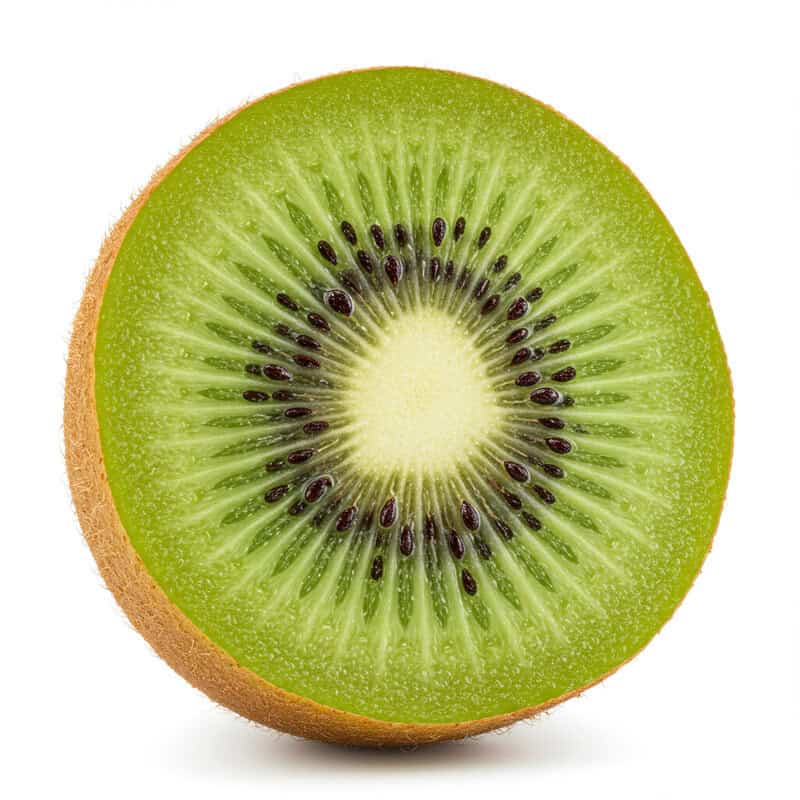
Kiwi is a nutrient-dense fruit that offers significant blood sugar benefits, thanks to its high vitamin C and fiber content. Vitamin C acts as a potent antioxidant, reducing inflammation and oxidative stress—two factors that can contribute to insulin resistance. The fiber in kiwi, especially when the skin is eaten, slows the absorption of sugar in the digestive tract and helps maintain steady blood glucose levels. According to a study in the Journal of Food Science, regular consumption of high-fiber, vitamin C-rich fruits like kiwi is associated with improved glycemic control and a reduced risk of type 2 diabetes.
When compared to bananas, kiwi contains fewer total carbohydrates and sugars per serving while providing more fiber and vitamin C. Bananas, although nutritious, have a higher glycemic index and can cause quicker increases in blood sugar, especially when very ripe. For healthy snacking, enjoy kiwi sliced on its own or paired with a handful of nuts for added satiety. Kiwi can also be added to fruit salads, blended into smoothies, or used as a tangy topping for yogurt or whole grain cereal. Its tart-sweet flavor and vibrant color make kiwi an appealing, blood sugar-friendly fruit for a variety of snacks and meals.
36. Okra
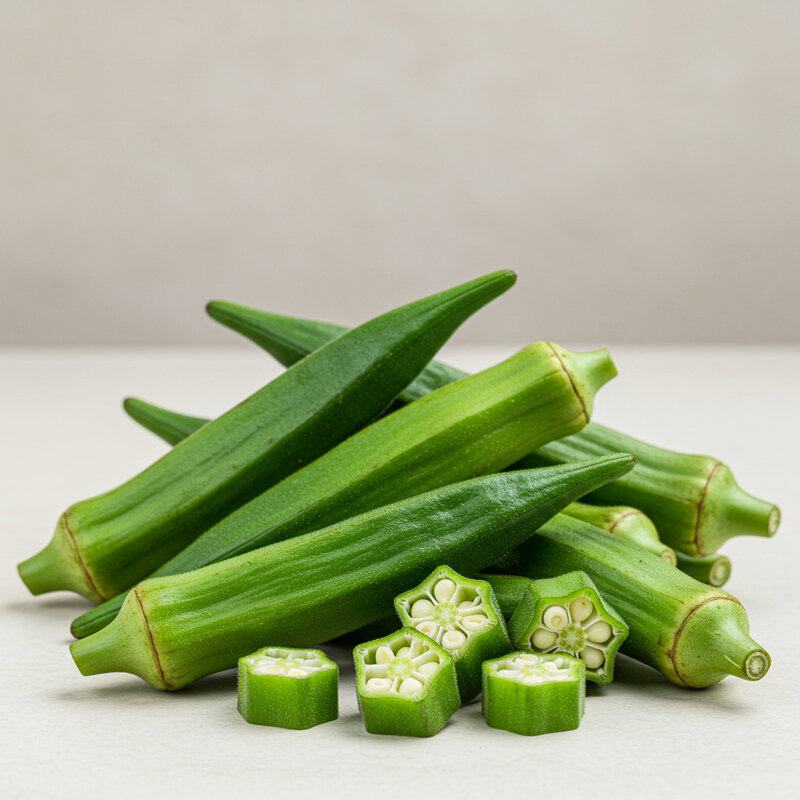
Okra is a vegetable rich in mucilage—a gel-like soluble fiber—and dietary fiber, both of which are beneficial for blood sugar regulation. The mucilage in okra slows the absorption of carbohydrates in the digestive tract, helping to prevent rapid spikes in blood glucose after meals. Its overall fiber content also promotes satiety and supports digestive health. Studies, such as one published in the Journal of Pharmacy & Bioallied Sciences, have found that okra supplementation may improve glycemic control and reduce fasting blood sugar levels in people with diabetes.
Compared to eggplant, another low-carb vegetable, okra stands out for its higher soluble fiber and mucilage content, which provide more pronounced effects on glucose management. Eggplant is also beneficial due to its fiber, but lacks the unique gel-like substance present in okra pods. For preparation, okra can be sliced and added to soups and stews, where its mucilage thickens the broth. It can also be roasted, grilled, or sautéed with spices for a flavorful side dish, or pickled for a tangy snack. Okra’s versatility and distinct texture make it a valuable addition to meals aimed at maintaining stable blood sugar levels.
37. Seaweed
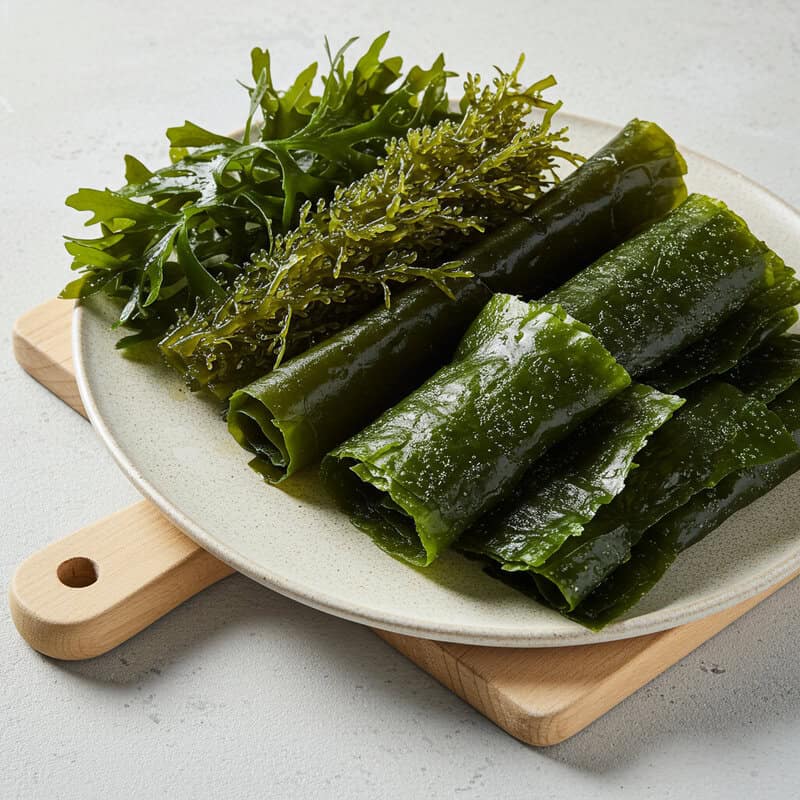
Seaweed is a unique, nutrient-rich food from the sea, recognized for its high content of alginate, a type of soluble fiber that can slow gastric emptying and reduce the absorption of glucose in the digestive tract. Alginate forms a gel-like substance, helping to blunt post-meal blood sugar spikes and promoting longer-lasting satiety. In addition, seaweed is a rich source of essential minerals such as iodine, magnesium, and calcium, which are important for metabolic health and may further support insulin function. According to research in the Marine Drugs journal, regular consumption of seaweed may help improve glycemic control and support cardiovascular health.
Compared to kale, a terrestrial leafy green, seaweed generally provides higher levels of minerals, particularly iodine, which supports thyroid health and metabolism. While kale is an excellent source of antioxidants and fiber, seaweed’s alginate content gives it a unique edge for blood sugar management. For safe consumption, enjoy seaweed in moderation, as excessive intake can lead to high iodine levels. Popular ways to eat seaweed include adding nori sheets to sushi, sprinkling dried seaweed over salads or rice bowls, or enjoying seaweed snacks. Always choose reputable brands to avoid contamination, and consult with your doctor if you have thyroid concerns.
38. Yogurt (Unsweetened)

Unsweetened yogurt is a powerhouse for blood sugar management, thanks to its combination of probiotics and high-quality protein. Probiotics are beneficial bacteria that support gut health and may improve insulin sensitivity by reducing inflammation and positively influencing gut microbiota. The protein in yogurt slows gastric emptying and the absorption of carbohydrates, preventing rapid spikes in blood glucose. Research published in Nutrients indicates that consuming unsweetened yogurt regularly can improve glycemic control and lower the risk of developing type 2 diabetes.
When compared to sweetened yogurts, unsweetened varieties contain no added sugars, making them a much better choice for blood sugar regulation. Sweetened yogurts often have high amounts of added sugar, which can cause post-meal blood glucose surges and contribute to metabolic issues. For healthy snacking, enjoy unsweetened yogurt on its own, or enhance its flavor with fresh berries, a sprinkle of cinnamon, or a handful of nuts and seeds. Yogurt can also be used as a base for smoothies, dips, or salad dressings. Choose plain, whole milk or low-fat yogurt with live active cultures for the greatest probiotic benefit and best support for steady blood sugar.
39. Red Bell Peppers
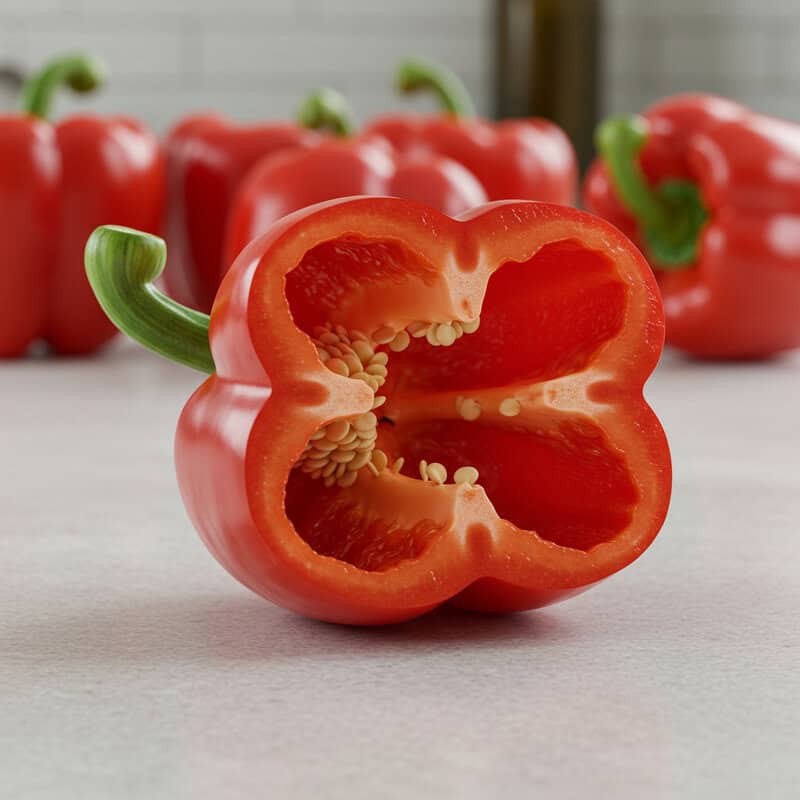
Red bell peppers are an excellent addition to a blood sugar-friendly diet, thanks to their high vitamin C content and rich supply of dietary fiber. Vitamin C acts as a potent antioxidant, helping to reduce inflammation and oxidative stress, both of which can hinder insulin sensitivity. The fiber in red bell peppers slows digestion and the absorption of sugars, promoting more stable blood glucose levels after meals. According to research in the Journal of Nutritional Biochemistry, diets high in antioxidant-rich vegetables like red bell peppers are associated with improved glycemic control and reduced risk of diabetes.
Compared to green bell peppers, red bell peppers are ripened longer on the vine and thus contain significantly more vitamin C and beta-carotene, while providing similar amounts of fiber and fewer sugars than many other fruits or vegetables. For practical snack ideas, enjoy raw red bell pepper slices with hummus or Greek yogurt dip, add them to salads for crunch and color, or roast and toss them with olive oil as a flavorful side dish. Red bell peppers can also be stuffed with lean proteins and grains for a balanced meal that supports healthy blood sugar management.
40. Blackberries
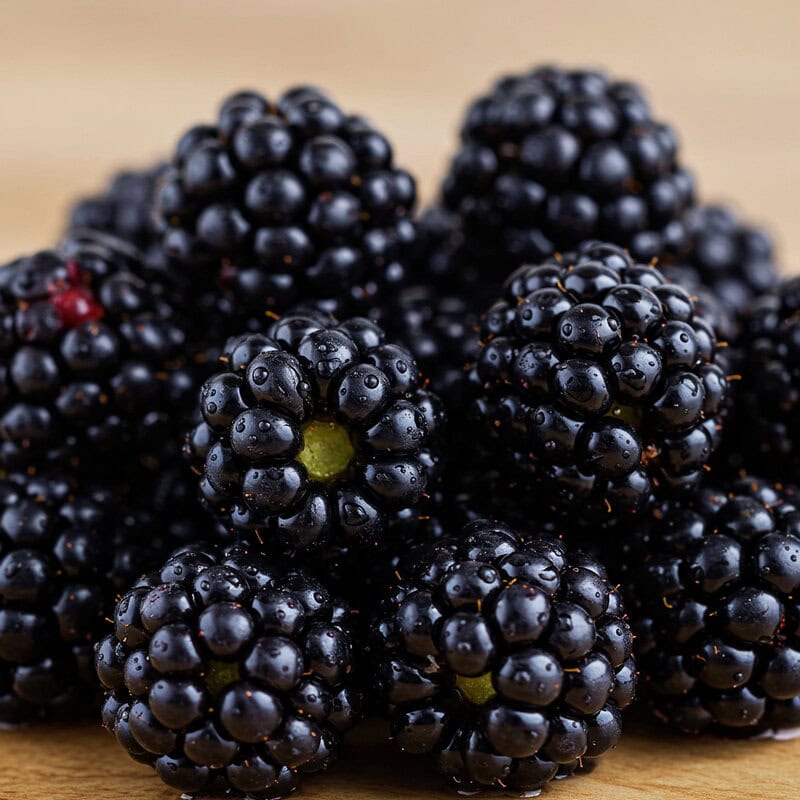
Blackberries are packed with antioxidants and dietary fiber, both of which work synergistically to support blood sugar control. The high fiber content in blackberries slows the digestion and absorption of carbohydrates, helping to prevent rapid spikes in blood glucose after meals. Additionally, antioxidants such as anthocyanins and vitamin C in blackberries have been shown to reduce inflammation and improve insulin sensitivity. Research published in the Journal of Nutritional Biochemistry indicates that regular consumption of berries, including blackberries, can contribute to improved glycemic control and a reduced risk of type 2 diabetes.
When compared to grapes, blackberries have a lower glycemic index and significantly more fiber per serving, which makes them a superior choice for those looking to maintain steady blood sugar. Grapes, while nutritious, contain more sugar and can cause quicker rises in blood glucose. For delicious snack ideas, enjoy blackberries fresh on their own, mix into Greek yogurt or oatmeal, or blend into smoothies with leafy greens for a nutrient boost. Blackberries can also be added to salads or used as a topping for whole grain pancakes or desserts. Their tart-sweet taste and versatility make blackberries a flavorful, blood sugar-friendly fruit.
41. Artichokes
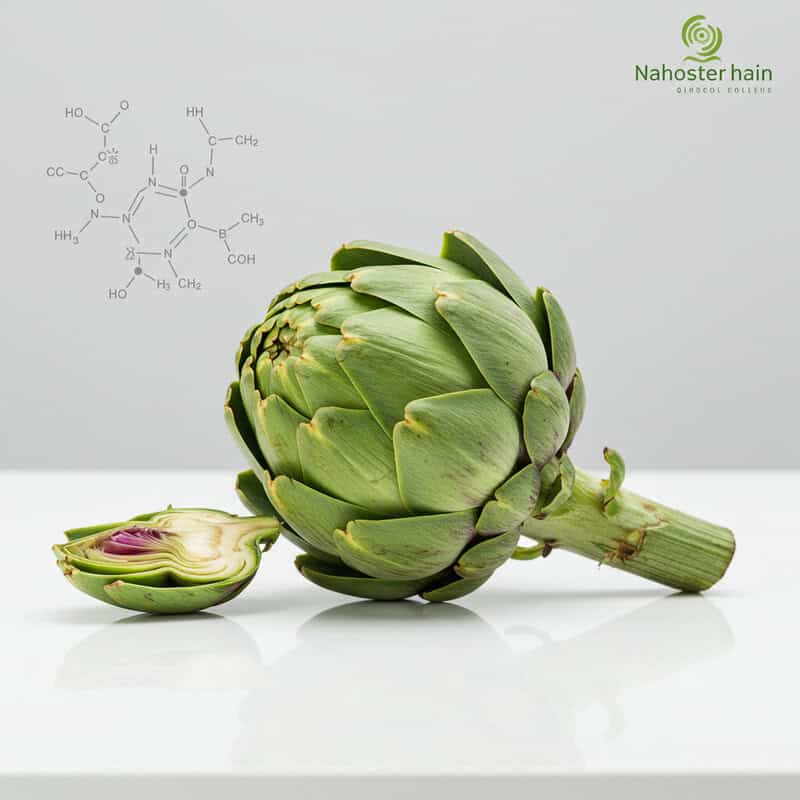
Artichokes are a unique vegetable renowned for their high content of inulin, a type of prebiotic soluble fiber that plays a significant role in regulating blood sugar. Inulin slows the absorption of glucose in the digestive tract, leading to more gradual increases in blood sugar after meals and supporting overall glycemic control. In addition, inulin promotes the growth of beneficial gut bacteria, which may further enhance insulin sensitivity and metabolic health. A study published in the British Journal of Nutrition highlights the positive effects of inulin-rich foods like artichokes on blood sugar regulation and gut health.
Compared to asparagus, which also contains prebiotic fiber and supports glucose control, artichokes are particularly high in inulin and provide a denser, more satisfying texture. Both vegetables are excellent choices for blood sugar management, but artichokes offer a unique flavor and fiber profile. To incorporate artichokes into meals, steam or boil whole artichokes and enjoy the tender leaves with a light vinaigrette, or use canned or marinated artichoke hearts in salads, grain bowls, or pasta dishes. Artichokes can also be roasted with olive oil and herbs for a savory side, making them a versatile and tasty addition to a blood sugar-friendly diet.
42. Peas
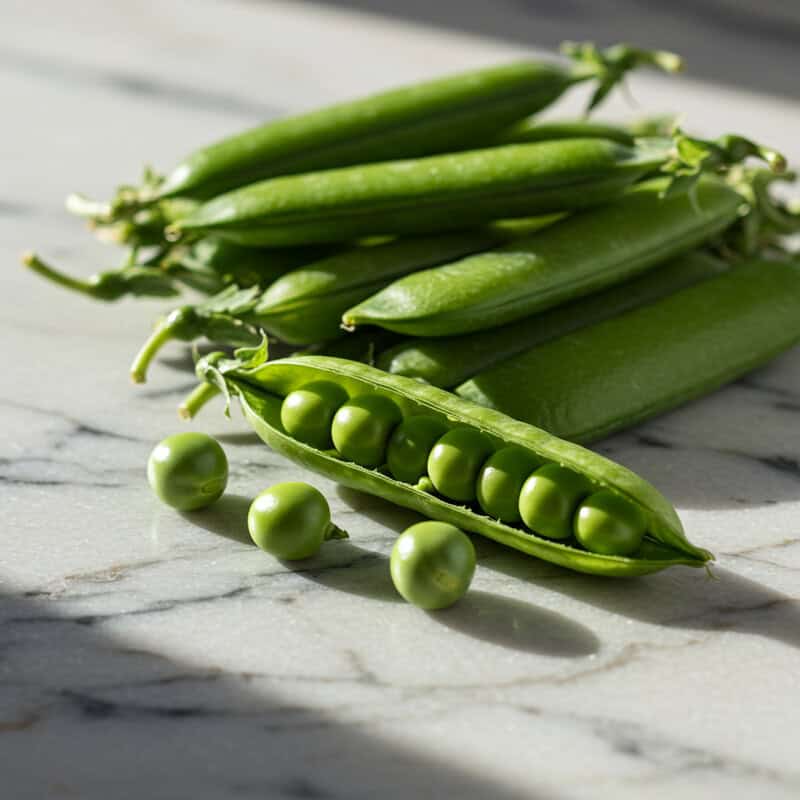
Peas are a nutrient-dense legume, offering a valuable combination of plant-based protein and dietary fiber that helps regulate blood sugar levels. The protein content in peas slows digestion and the absorption of carbohydrates, while the fiber—both soluble and insoluble—delays glucose release into the bloodstream, reducing the risk of post-meal spikes. According to research published in the Journal of the Science of Food and Agriculture, regular consumption of peas can contribute to improved glycemic response and overall metabolic health.
When compared to corn, peas provide more protein and fiber per serving, and have a lower glycemic index. Corn, while sweet and flavorful, is higher in starchy carbohydrates that can lead to sharper increases in blood glucose. Peas are also a good source of vitamins C, K, and several B vitamins, as well as minerals like iron and magnesium. For serving ideas, add peas to soups, stews, and salads, mash them as a spread, or toss them into stir-fries and grain bowls. Fresh, frozen, or even lightly steamed peas make a sweet, satisfying side dish or snack that supports stable blood sugar and overall nutrition.
43. Cottage Cheese

Cottage cheese is a high-protein, low-carbohydrate dairy food that can help stabilize blood sugar and support satiety. Its substantial protein content slows digestion and the absorption of any accompanying carbohydrates, resulting in a gradual release of glucose into the bloodstream. This effect can help prevent blood sugar spikes and promote feelings of fullness, making cottage cheese an excellent choice for those managing diabetes or seeking to maintain stable energy levels. According to research in the Journal of Nutrition, higher dairy protein intake is associated with improved glycemic control and reduced risk of metabolic diseases.
Compared to ricotta cheese, cottage cheese generally contains more protein and fewer carbohydrates per serving. Ricotta is creamier and higher in fat, but has a slightly higher carb content, which may not be ideal for strict blood sugar management. For healthy snack ideas, enjoy cottage cheese on its own, topped with berries or sliced cucumber, or mixed with a handful of nuts and seeds. It can be used as a savory dip for raw vegetables, blended into smoothies for a creamy texture, or spread on whole grain toast. Its mild flavor and versatility make cottage cheese a blood sugar-friendly snack or meal component.
44. Watermelon (in Moderation)
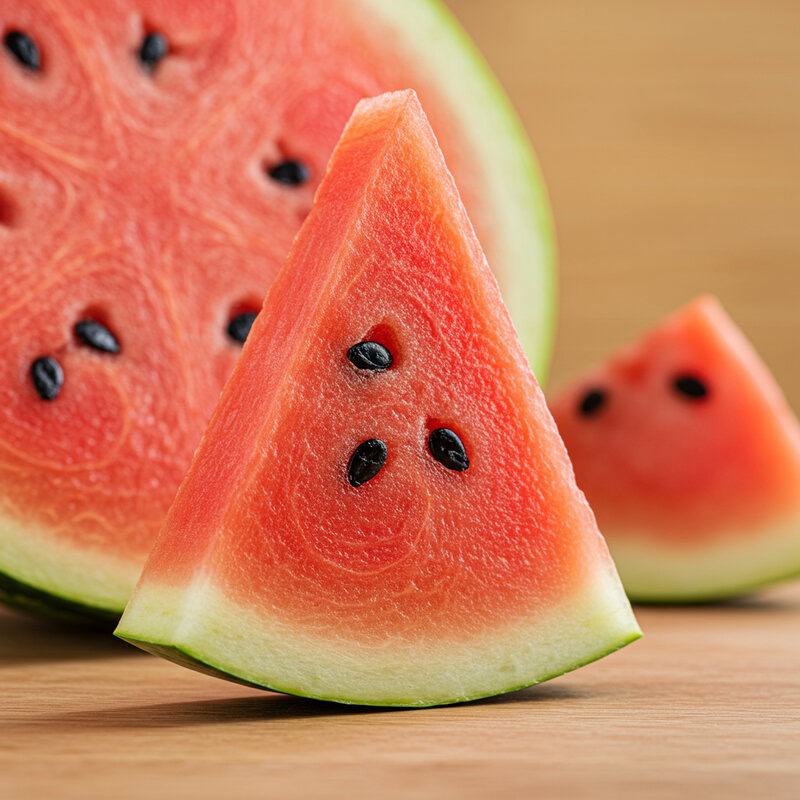
Watermelon is a hydrating fruit, comprised of over 90% water, which makes it refreshing and beneficial for maintaining fluid balance, especially in warmer months. While watermelon has a high glycemic index, its overall glycemic load is moderate due to the low carbohydrate content in a typical serving size. This means that when consumed in moderation, watermelon can fit into a blood sugar-friendly diet without causing significant spikes in glucose. According to the Journal of Ethnic Foods, the hydration and antioxidant properties of watermelon, such as lycopene, offer further support for metabolic and cardiovascular health.
Compared to cantaloupe, watermelon contains fewer carbohydrates per serving and is lower in calories, making it a slightly better choice for those monitoring blood sugar. Cantaloupe, while also hydrating and rich in vitamins, has a slightly higher glycemic load and more natural sugars per portion. For safe consumption, enjoy watermelon in small, measured portions—such as a cup of cubes—and combine with a source of protein or healthy fat, like a handful of nuts, to slow glucose absorption. Avoid juicing watermelon or consuming it in large quantities, as this can increase its impact on blood sugar. Pairing moderation with mindful eating makes watermelon a safe, refreshing treat.
45. Eggplant

Eggplant is a nutrient-dense, low-carbohydrate vegetable known for its significant fiber content and rich supply of antioxidants, particularly nasunin found in its purple skin. The fiber in eggplant slows the digestion and absorption of carbohydrates, helping to stabilize post-meal blood sugar levels and promote satiety. Its antioxidants protect cells from oxidative stress, which is linked to improved insulin sensitivity and reduced risk of metabolic syndrome. Research in the Journal of Functional Foods demonstrates that regular consumption of eggplant may support healthy glucose and cholesterol levels.
When compared to zucchini, eggplant offers a meatier texture and slightly more fiber per serving, while both vegetables are excellent low-carb options for blood sugar management. Zucchini has a milder flavor, but eggplant’s robust taste makes it ideal for hearty dishes. For healthy recipes, try roasting eggplant with olive oil and herbs, grilling slices for sandwiches, or baking it into casseroles like ratatouille or moussaka. Eggplant can also be cubed and added to stir-fries, or blended into dips such as baba ganoush. Its versatility and nutritional profile make eggplant a flavorful and satisfying addition to a diet focused on stable blood sugar control.
46. Brown Rice
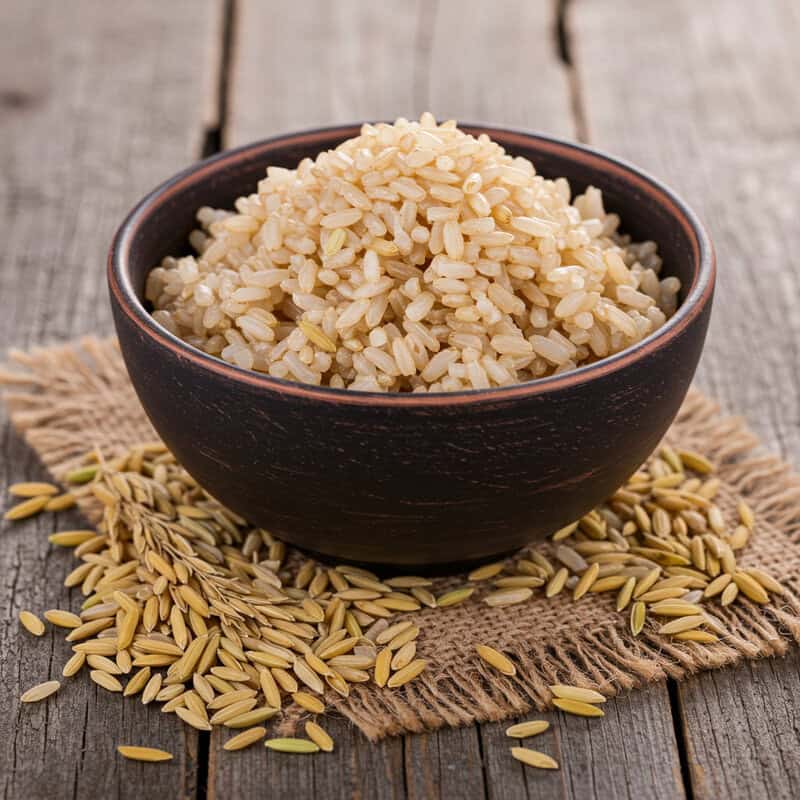
Brown rice is a whole grain that retains its bran and germ, making it a richer source of dietary fiber, vitamins, and minerals compared to white rice. The fiber in brown rice slows the digestion and absorption of carbohydrates, resulting in a more gradual increase in blood sugar after meals and supporting overall glycemic control. Research published in the Journal of Nutritional Biochemistry highlights that substituting brown rice for white rice may lead to better blood sugar management and a reduced risk of developing type 2 diabetes.
When compared to white rice, brown rice has a lower glycemic index and more fiber, which helps reduce postprandial glucose spikes. White rice is more processed and quickly broken down into glucose, often leading to rapid increases in blood sugar levels. For serving tips, use brown rice as a base for grain bowls, stir-fries, and salads, or pair it with beans and vegetables for a balanced, nutrient-rich meal. To enhance flavor and nutrition, cook brown rice in low-sodium broth and mix with herbs and spices. Portion control is important—stick to about half a cup cooked per serving to support healthy blood sugar while enjoying the benefits of whole grains.
47. Plums
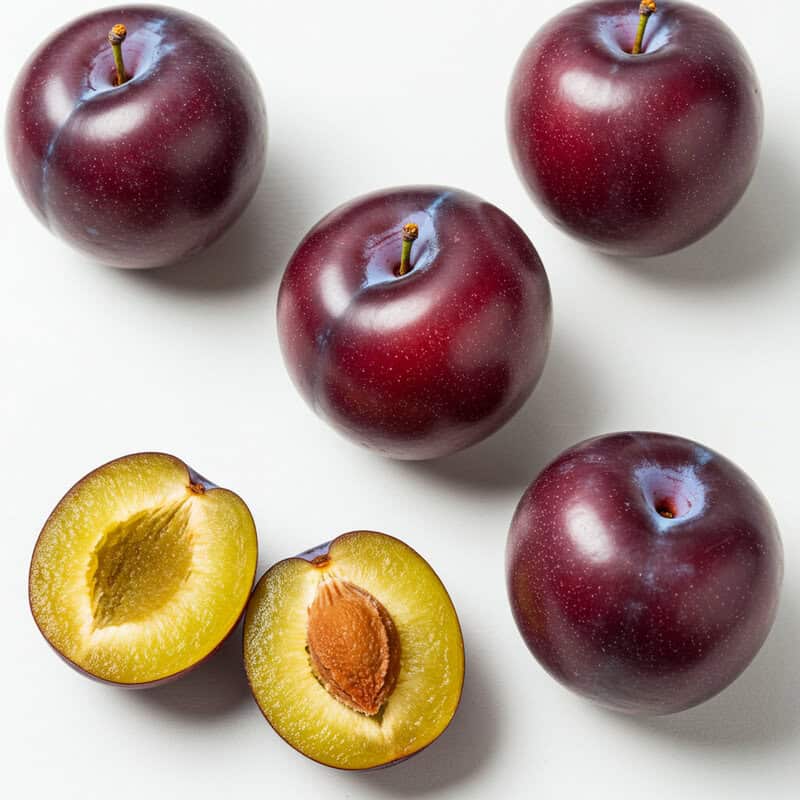
Plums are a delicious, low-calorie fruit rich in polyphenols and dietary fiber, both of which play important roles in supporting healthy blood sugar management. Polyphenols in plums act as antioxidants, helping to reduce inflammation and improve insulin sensitivity, while the fiber content slows the digestion and absorption of sugars, resulting in more stable glucose levels. Research published in the Journal of Medicinal Food suggests that regular consumption of polyphenol-rich fruits like plums is associated with a reduced risk of type 2 diabetes and better glycemic control.
When compared to dried prunes, fresh plums have a lower concentration of natural sugars and calories per serving, making them a better option for those monitoring blood sugar. Prunes are more calorie-dense due to water loss during drying, and their sugar content is more concentrated, which can cause quicker glucose spikes if eaten in large amounts. For healthy snacking, enjoy fresh plums sliced on their own, added to fruit salads, or paired with a handful of nuts for extra satiety. Plums can also be grilled for a unique dessert or added to yogurt and oatmeal for a naturally sweet flavor boost without added sugars.
48. Radishes

Radishes are a crisp, low-carbohydrate root vegetable that offers unique blood sugar benefits thanks to their glucosinolate compounds and high water content. Glucosinolates are plant-based compounds with antioxidant and anti-inflammatory properties, which may help improve insulin sensitivity and protect against oxidative stress that can disrupt glucose metabolism. Radishes are also extremely low in carbohydrates, meaning they have a minimal impact on blood sugar levels, making them ideal for those managing diabetes or seeking stable glucose control. According to research in the Journal of Medicinal Food, radish extracts have demonstrated the potential to improve glucose uptake and reduce blood sugar in animal studies.
Compared to turnips, radishes contain fewer carbohydrates and are usually eaten raw, which preserves their nutrients and crunchy texture. Turnips, while also low in carbs and rich in fiber, have a slightly earthier flavor and are often cooked, which can make them more versatile in hot dishes. For healthy snacks, enjoy radish slices with hummus or tzatziki, add them to salads for a peppery crunch, or pickle them for a tangy, probiotic-rich treat. Their vibrant color and refreshing taste make radishes a satisfying, blood sugar-friendly addition to any snack plate or meal.
49. Chickpeas

Chickpeas, also known as garbanzo beans, are an excellent source of plant-based protein and soluble fiber—two nutrients that play a crucial role in stabilizing blood sugar. The protein in chickpeas slows the digestive process, while the soluble fiber forms a gel in the gut, further reducing the speed at which carbohydrates are absorbed into the bloodstream. This combination helps prevent post-meal glucose spikes and supports long-lasting satiety. According to research published in the Archives of Internal Medicine, regular consumption of chickpeas can improve glycemic control and reduce cardiovascular risk in people with diabetes.
When compared to lentils, chickpeas are slightly higher in carbohydrates but also richer in certain minerals such as manganese and copper. Both legumes offer similar protein and fiber benefits, but chickpeas have a slightly firmer texture, making them versatile for a range of dishes. For meal ideas, add chickpeas to salads, soups, or stews, blend them into hummus for a creamy dip, or roast them with spices for a crunchy snack. You can also use chickpeas as a base for vegetarian patties or falafel. Their mild, nutty flavor makes chickpeas a satisfying and blood sugar-friendly addition to many meals.
50. Apples

Apples are a classic, nutrient-rich fruit celebrated for their high content of pectin, a type of soluble fiber that plays a significant role in blood sugar control. Pectin slows the digestion and absorption of carbohydrates, resulting in a more gradual release of glucose into the bloodstream and helping to prevent sharp spikes in blood sugar after meals. Research published in the Journal of Food Science indicates that regular consumption of apples is associated with improved glycemic control and a reduced risk of developing type 2 diabetes.
When compared to pears, apples offer a similar amount of dietary fiber and have a comparable glycemic index, making both fruits excellent choices for stable blood sugar management. Pears do have slightly more soluble fiber, but apples are more widely available and come in a variety of flavors and textures. For healthy snacks, enjoy apples sliced with a handful of nuts for protein and healthy fats, diced in salads, or baked with cinnamon for a naturally sweet dessert. Eating apples with the skin maximizes fiber intake and enhances their blood sugar benefits. Their crisp texture and natural sweetness make apples a convenient and satisfying choice for any meal or snack.
Conclusion
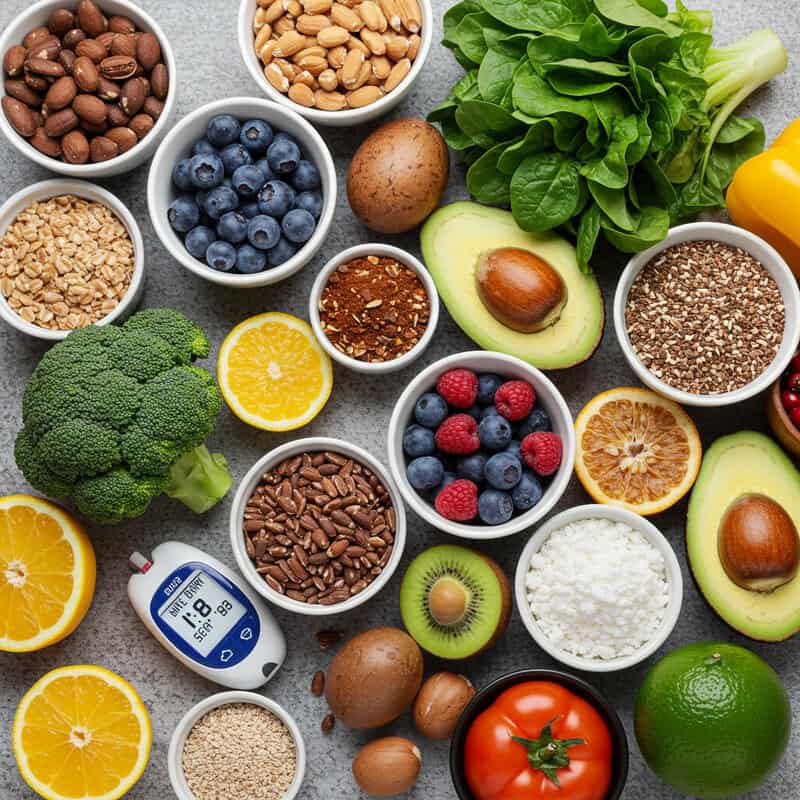
Managing blood sugar is critical for preventing diabetes and its complications, especially given the global rise in metabolic disorders. As highlighted, selecting the right foods—rich in fiber, antioxidants, and healthy fats—can help stabilize glucose levels and support overall health. However, food choices are just one part of an effective strategy. Regular blood sugar screening and ongoing dialogue with healthcare professionals are essential for early detection and personalized care. For more information on diabetes prevention and management, visit the CDC’s Diabetes Management page. By making informed dietary decisions and staying proactive about your health, you can take meaningful steps toward balanced blood sugar and long-term wellness.
Disclaimer
The information provided in this article is for general informational purposes only. While we strive to keep the information up-to-date and correct, we make no representations or warranties of any kind, express or implied, about the completeness, accuracy, reliability, suitability, or availability with respect to the article or the information, products, services, or related graphics contained in the article for any purpose. Any reliance you place on such information is therefore strictly at your own risk.
In no event will we be liable for any loss or damage including without limitation, indirect or consequential loss or damage, or any loss or damage whatsoever arising from loss of data or profits arising out of, or in connection with, the use of this article.
Through this article you are able to link to other websites which are not under our control. We have no control over the nature, content, and availability of those sites. The inclusion of any links does not necessarily imply a recommendation or endorse the views expressed within them.
Every effort is made to keep the article up and running smoothly. However, we take no responsibility for, and will not be liable for, the article being temporarily unavailable due to technical issues beyond our control.





